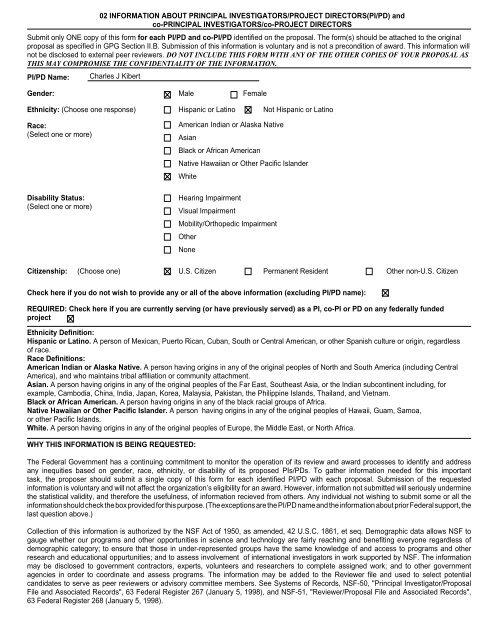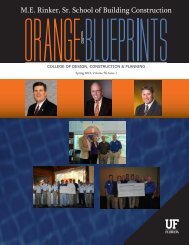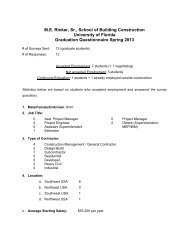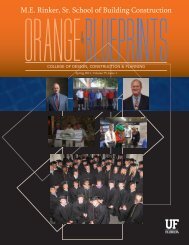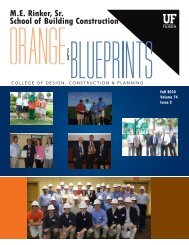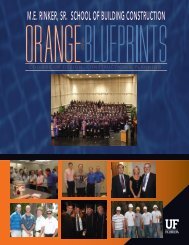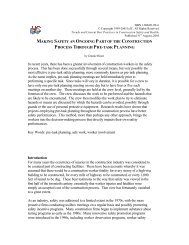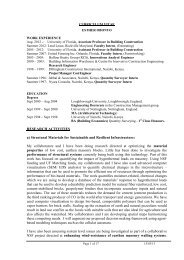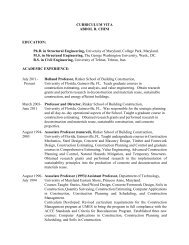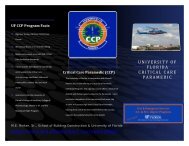Full Proposal in pdf - M E Rinker Sr School of Building Construction ...
Full Proposal in pdf - M E Rinker Sr School of Building Construction ...
Full Proposal in pdf - M E Rinker Sr School of Building Construction ...
You also want an ePaper? Increase the reach of your titles
YUMPU automatically turns print PDFs into web optimized ePapers that Google loves.
02 INFORMATION ABOUT PRINCIPAL INVESTIGATORS/PROJECT DIRECTORS(PI/PD) andco-PRINCIPAL INVESTIGATORS/co-PROJECT DIRECTORSSubmit only ONE copy <strong>of</strong> this form for each PI/PD and co-PI/PD identified on the proposal. The form(s) should be attached to the orig<strong>in</strong>alproposal as specified <strong>in</strong> GPG Section II.B. Submission <strong>of</strong> this <strong>in</strong>formation is voluntary and is not a precondition <strong>of</strong> award. This <strong>in</strong>formation willnot be disclosed to external peer reviewers. DO NOT INCLUDE THIS FORM WITH ANY OF THE OTHER COPIES OF YOUR PROPOSAL ASTHIS MAY COMPROMISE THE CONFIDENTIALITY OF THE INFORMATION.PI/PD Name: Charles J KibertGender: Male FemaleEthnicity: (Choose one response) Hispanic or Lat<strong>in</strong>o Not Hispanic or Lat<strong>in</strong>oRace:(Select one or more)Disability Status:(Select one or more)American Indian or Alaska NativeAsianBlack or African AmericanNative Hawaiian or Other Pacific IslanderWhiteHear<strong>in</strong>g ImpairmentVisual ImpairmentMobility/Orthopedic ImpairmentOtherNoneCitizenship: (Choose one) U.S. Citizen Permanent Resident Other non-U.S. CitizenCheck here if you do not wish to provide any or all <strong>of</strong> the above <strong>in</strong>formation (exclud<strong>in</strong>g PI/PD name):REQUIRED: Check here if you are currently serv<strong>in</strong>g (or have previously served) as a PI, co-PI or PD on any federally fundedprojectEthnicity Def<strong>in</strong>ition:Hispanic or Lat<strong>in</strong>o. A person <strong>of</strong> Mexican, Puerto Rican, Cuban, South or Central American, or other Spanish culture or orig<strong>in</strong>, regardless<strong>of</strong> race.Race Def<strong>in</strong>itions:American Indian or Alaska Native. A person hav<strong>in</strong>g orig<strong>in</strong>s <strong>in</strong> any <strong>of</strong> the orig<strong>in</strong>al peoples <strong>of</strong> North and South America (<strong>in</strong>clud<strong>in</strong>g CentralAmerica), and who ma<strong>in</strong>ta<strong>in</strong>s tribal affiliation or community attachment.Asian. A person hav<strong>in</strong>g orig<strong>in</strong>s <strong>in</strong> any <strong>of</strong> the orig<strong>in</strong>al peoples <strong>of</strong> the Far East, Southeast Asia, or the Indian subcont<strong>in</strong>ent <strong>in</strong>clud<strong>in</strong>g, forexample, Cambodia, Ch<strong>in</strong>a, India, Japan, Korea, Malaysia, Pakistan, the Philipp<strong>in</strong>e Islands, Thailand, and Vietnam.Black or African American. A person hav<strong>in</strong>g orig<strong>in</strong>s <strong>in</strong> any <strong>of</strong> the black racial groups <strong>of</strong> Africa.Native Hawaiian or Other Pacific Islander. A person hav<strong>in</strong>g orig<strong>in</strong>s <strong>in</strong> any <strong>of</strong> the orig<strong>in</strong>al peoples <strong>of</strong> Hawaii, Guam, Samoa,or other Pacific Islands.White. A person hav<strong>in</strong>g orig<strong>in</strong>s <strong>in</strong> any <strong>of</strong> the orig<strong>in</strong>al peoples <strong>of</strong> Europe, the Middle East, or North Africa.WHY THIS INFORMATION IS BEING REQUESTED:The Federal Government has a cont<strong>in</strong>u<strong>in</strong>g commitment to monitor the operation <strong>of</strong> its review and award processes to identify and addressany <strong>in</strong>equities based on gender, race, ethnicity, or disability <strong>of</strong> its proposed PIs/PDs. To gather <strong>in</strong>formation needed for this importanttask, the proposer should submit a s<strong>in</strong>gle copy <strong>of</strong> this form for each identified PI/PD with each proposal. Submission <strong>of</strong> the requested<strong>in</strong>formation is voluntary and will not affect the organization’s eligibility for an award. However, <strong>in</strong>formation not submitted will seriously underm<strong>in</strong>ethe statistical validity, and therefore the usefulness, <strong>of</strong> <strong>in</strong>formation recieved from others. Any <strong>in</strong>dividual not wish<strong>in</strong>g to submit some or all the<strong>in</strong>formation should check the box provided for this purpose. (The exceptions are the PI/PD name and the <strong>in</strong>formation about prior Federal support, thelast question above.)Collection <strong>of</strong> this <strong>in</strong>formation is authorized by the NSF Act <strong>of</strong> 1950, as amended, 42 U.S.C. 1861, et seq. Demographic data allows NSF togauge whether our programs and other opportunities <strong>in</strong> science and technology are fairly reach<strong>in</strong>g and benefit<strong>in</strong>g everyone regardless <strong>of</strong>demographic category; to ensure that those <strong>in</strong> under-represented groups have the same knowledge <strong>of</strong> and access to programs and otherresearch and educational oppurtunities; and to assess <strong>in</strong>volvement <strong>of</strong> <strong>in</strong>ternational <strong>in</strong>vestigators <strong>in</strong> work supported by NSF. The <strong>in</strong>formationmay be disclosed to government contractors, experts, volunteers and researchers to complete assigned work; and to other governmentagencies <strong>in</strong> order to coord<strong>in</strong>ate and assess programs. The <strong>in</strong>formation may be added to the Reviewer file and used to select potentialcandidates to serve as peer reviewers or advisory committee members. See Systems <strong>of</strong> Records, NSF-50, "Pr<strong>in</strong>cipal Investigator/<strong>Proposal</strong>File and Associated Records", 63 Federal Register 267 (January 5, 1998), and NSF-51, "Reviewer/<strong>Proposal</strong> File and Associated Records",63 Federal Register 268 (January 5, 1998).
02 INFORMATION ABOUT PRINCIPAL INVESTIGATORS/PROJECT DIRECTORS(PI/PD) andco-PRINCIPAL INVESTIGATORS/co-PROJECT DIRECTORSSubmit only ONE copy <strong>of</strong> this form for each PI/PD and co-PI/PD identified on the proposal. The form(s) should be attached to the orig<strong>in</strong>alproposal as specified <strong>in</strong> GPG Section II.B. Submission <strong>of</strong> this <strong>in</strong>formation is voluntary and is not a precondition <strong>of</strong> award. This <strong>in</strong>formation willnot be disclosed to external peer reviewers. DO NOT INCLUDE THIS FORM WITH ANY OF THE OTHER COPIES OF YOUR PROPOSAL ASTHIS MAY COMPROMISE THE CONFIDENTIALITY OF THE INFORMATION.PI/PD Name: Svetlana Olb<strong>in</strong>aGender: Male FemaleEthnicity: (Choose one response) Hispanic or Lat<strong>in</strong>o Not Hispanic or Lat<strong>in</strong>oRace:(Select one or more)Disability Status:(Select one or more)American Indian or Alaska NativeAsianBlack or African AmericanNative Hawaiian or Other Pacific IslanderWhiteHear<strong>in</strong>g ImpairmentVisual ImpairmentMobility/Orthopedic ImpairmentOtherNoneCitizenship: (Choose one) U.S. Citizen Permanent Resident Other non-U.S. CitizenCheck here if you do not wish to provide any or all <strong>of</strong> the above <strong>in</strong>formation (exclud<strong>in</strong>g PI/PD name):REQUIRED: Check here if you are currently serv<strong>in</strong>g (or have previously served) as a PI, co-PI or PD on any federally fundedprojectEthnicity Def<strong>in</strong>ition:Hispanic or Lat<strong>in</strong>o. A person <strong>of</strong> Mexican, Puerto Rican, Cuban, South or Central American, or other Spanish culture or orig<strong>in</strong>, regardless<strong>of</strong> race.Race Def<strong>in</strong>itions:American Indian or Alaska Native. A person hav<strong>in</strong>g orig<strong>in</strong>s <strong>in</strong> any <strong>of</strong> the orig<strong>in</strong>al peoples <strong>of</strong> North and South America (<strong>in</strong>clud<strong>in</strong>g CentralAmerica), and who ma<strong>in</strong>ta<strong>in</strong>s tribal affiliation or community attachment.Asian. A person hav<strong>in</strong>g orig<strong>in</strong>s <strong>in</strong> any <strong>of</strong> the orig<strong>in</strong>al peoples <strong>of</strong> the Far East, Southeast Asia, or the Indian subcont<strong>in</strong>ent <strong>in</strong>clud<strong>in</strong>g, forexample, Cambodia, Ch<strong>in</strong>a, India, Japan, Korea, Malaysia, Pakistan, the Philipp<strong>in</strong>e Islands, Thailand, and Vietnam.Black or African American. A person hav<strong>in</strong>g orig<strong>in</strong>s <strong>in</strong> any <strong>of</strong> the black racial groups <strong>of</strong> Africa.Native Hawaiian or Other Pacific Islander. A person hav<strong>in</strong>g orig<strong>in</strong>s <strong>in</strong> any <strong>of</strong> the orig<strong>in</strong>al peoples <strong>of</strong> Hawaii, Guam, Samoa,or other Pacific Islands.White. A person hav<strong>in</strong>g orig<strong>in</strong>s <strong>in</strong> any <strong>of</strong> the orig<strong>in</strong>al peoples <strong>of</strong> Europe, the Middle East, or North Africa.WHY THIS INFORMATION IS BEING REQUESTED:The Federal Government has a cont<strong>in</strong>u<strong>in</strong>g commitment to monitor the operation <strong>of</strong> its review and award processes to identify and addressany <strong>in</strong>equities based on gender, race, ethnicity, or disability <strong>of</strong> its proposed PIs/PDs. To gather <strong>in</strong>formation needed for this importanttask, the proposer should submit a s<strong>in</strong>gle copy <strong>of</strong> this form for each identified PI/PD with each proposal. Submission <strong>of</strong> the requested<strong>in</strong>formation is voluntary and will not affect the organization’s eligibility for an award. However, <strong>in</strong>formation not submitted will seriously underm<strong>in</strong>ethe statistical validity, and therefore the usefulness, <strong>of</strong> <strong>in</strong>formation recieved from others. Any <strong>in</strong>dividual not wish<strong>in</strong>g to submit some or all the<strong>in</strong>formation should check the box provided for this purpose. (The exceptions are the PI/PD name and the <strong>in</strong>formation about prior Federal support, thelast question above.)Collection <strong>of</strong> this <strong>in</strong>formation is authorized by the NSF Act <strong>of</strong> 1950, as amended, 42 U.S.C. 1861, et seq. Demographic data allows NSF togauge whether our programs and other opportunities <strong>in</strong> science and technology are fairly reach<strong>in</strong>g and benefit<strong>in</strong>g everyone regardless <strong>of</strong>demographic category; to ensure that those <strong>in</strong> under-represented groups have the same knowledge <strong>of</strong> and access to programs and otherresearch and educational oppurtunities; and to assess <strong>in</strong>volvement <strong>of</strong> <strong>in</strong>ternational <strong>in</strong>vestigators <strong>in</strong> work supported by NSF. The <strong>in</strong>formationmay be disclosed to government contractors, experts, volunteers and researchers to complete assigned work; and to other governmentagencies <strong>in</strong> order to coord<strong>in</strong>ate and assess programs. The <strong>in</strong>formation may be added to the Reviewer file and used to select potentialcandidates to serve as peer reviewers or advisory committee members. See Systems <strong>of</strong> Records, NSF-50, "Pr<strong>in</strong>cipal Investigator/<strong>Proposal</strong>File and Associated Records", 63 Federal Register 267 (January 5, 1998), and NSF-51, "Reviewer/<strong>Proposal</strong> File and Associated Records",63 Federal Register 268 (January 5, 1998).
List <strong>of</strong> Suggested Reviewers or Reviewers Not To Include (optional)SUGGESTED REVIEWERS:Not ListedREVIEWERS NOT TO INCLUDE:Not Listed
COVER SHEET FOR PROPOSAL TO THE NATIONAL SCIENCE FOUNDATIONPROGRAM ANNOUNCEMENT/SOLICITATION NO./CLOSING DATE/if not <strong>in</strong> response to a program announcement/solicitation enter NSF 04-23PD 05-1631 10/01/05FOR CONSIDERATION BY NSF ORGANIZATION UNIT(S)CMS - INFO TECH & INFRASTRUCT SYSTEM(Indicate the most specific unit known, i.e. program, division, etc.)FOR NSF USE ONLYNSF PROPOSAL NUMBERDATE RECEIVED NUMBER OF COPIES DIVISION ASSIGNED FUND CODE DUNS# (Data Universal Number<strong>in</strong>g System) FILE LOCATIONEMPLOYER IDENTIFICATION NUMBER (EIN) ORTAXPAYER IDENTIFICATION NUMBER (TIN)NAME OF ORGANIZATION TO WHICH AWARD SHOULD BE MADEAWARDEE ORGANIZATION CODE (IF KNOWN)NAME OF PERFORMING ORGANIZATION, IF DIFFERENT FROM ABOVESHOW PREVIOUS AWARD NO. IF THIS ISA RENEWALAN ACCOMPLISHMENT-BASED RENEWALIS THIS PROPOSAL BEING SUBMITTED TO ANOTHER FEDERALAGENCY? YES NO IF YES, LIST ACRONYM(S)ADDRESS OF AWARDEE ORGANIZATION, INCLUDING 9 DIGIT ZIP CODE055516509/26/2005 10 07030000 CMS 1631 96966381409/27/2005 3:33pm S596002052University <strong>of</strong> Florida0015354000University <strong>of</strong> Florida219 Gr<strong>in</strong>ter HallGa<strong>in</strong>esville, FL. 326115500ADDRESS OF PERFORMING ORGANIZATION, IF DIFFERENT, INCLUDING 9 DIGIT ZIP CODEPERFORMING ORGANIZATION CODE (IF KNOWN)IS AWARDEE ORGANIZATION (Check All That Apply) SMALL BUSINESS MINORITY BUSINESS IF THIS IS A PRELIMINARY PROPOSAL(See GPG II.C For Def<strong>in</strong>itions) FOR-PROFIT ORGANIZATION WOMAN-OWNED BUSINESS THEN CHECK HERETITLE OF PROPOSED PROJECTDecision Model to Optimize Indoor Air Quality <strong>in</strong> Commercial Build<strong>in</strong>gsREQUESTED AMOUNTPROPOSED DURATION (1-60 MONTHS) REQUESTED STARTING DATE SHOW RELATED PRELIMINARY PROPOSAL NO.$ 228,007 24 months01/01/06IF APPLICABLECHECK APPROPRIATE BOX(ES) IF THIS PROPOSAL INCLUDES ANY OF THE ITEMS LISTED BELOWBEGINNING INVESTIGATOR (GPG I.A)DISCLOSURE OF LOBBYING ACTIVITIES (GPG II.C)HUMAN SUBJECTS (GPG II.D.6)Exemption Subsectionor IRB App. DatePROPRIETARY & PRIVILEGED INFORMATION (GPG I.B, II.C.1.d)HISTORIC PLACES (GPG II.C.2.j)INTERNATIONAL COOPERATIVE ACTIVITIES: COUNTRY/COUNTRIES INVOLVED(GPG II.C.2.j)SMALL GRANT FOR EXPLOR. RESEARCH (SGER) (GPG II.D.1)VERTEBRATE ANIMALS (GPG II.D.5) IACUC App. DateHIGH RESOLUTION GRAPHICS/OTHER GRAPHICS WHERE EXACT COLORREPRESENTATION IS REQUIRED FOR PROPER INTERPRETATION (GPG I.G.1)PI/PD DEPARTMENTPowell Center for <strong>Construction</strong> and Env.PI/PD FAX NUMBER352-392-9606PI/PD POSTAL ADDRESSNAMES (TYPED) High Degree Yr <strong>of</strong> Degree Telephone Number Electronic Mail AddressPI/PD NAMECO-PI/PDCO-PI/PDCO-PI/PD304 R<strong>in</strong>kerPO Box 115703Ga<strong>in</strong>esville, FL 326115703United StatesCharles J Kibert PhD 1982 352-273-1189 ckibert@ufl.eduKev<strong>in</strong> R Grosskopf PhD 1998 352-273-1158 kgro@ufl.eduSvetlana Olb<strong>in</strong>a PhD 2005 352-273-1166 solb<strong>in</strong>a@ufl.eduCO-PI/PDPage 1 <strong>of</strong> 2Electronic Signature
CERTIFICATION PAGECertification for Authorized Organizational Representative or Individual Applicant:By sign<strong>in</strong>g and submitt<strong>in</strong>g this proposal, the <strong>in</strong>dividual applicant or the authorized <strong>of</strong>ficial <strong>of</strong> the applicant <strong>in</strong>stitution is: (1) certify<strong>in</strong>g thatstatements made here<strong>in</strong> are true and complete to the best <strong>of</strong> his/her knowledge; and (2) agree<strong>in</strong>g to accept the obligation to comply with NSFaward terms and conditions if an award is made as a result <strong>of</strong> this application. Further, the applicant is hereby provid<strong>in</strong>g certificationsregard<strong>in</strong>g debarment and suspension, drug-free workplace, and lobby<strong>in</strong>g activities (see below), as set forth <strong>in</strong> Grant<strong>Proposal</strong> Guide (GPG), NSF 04-23. Willful provision <strong>of</strong> false <strong>in</strong>formation <strong>in</strong> this application and its support<strong>in</strong>g documents or <strong>in</strong> reports requiredunder an ensu<strong>in</strong>g award is a crim<strong>in</strong>al <strong>of</strong>fense (U. S. Code, Title 18, Section 1001).In addition, if the applicant <strong>in</strong>stitution employs more than fifty persons, the authorized <strong>of</strong>ficial <strong>of</strong> the applicant <strong>in</strong>stitution is certify<strong>in</strong>g that the <strong>in</strong>stitution hasimplemented a written and enforced conflict <strong>of</strong> <strong>in</strong>terest policy that is consistent with the provisions <strong>of</strong> Grant Policy Manual Section 510; that to the best<strong>of</strong> his/her knowledge, all f<strong>in</strong>ancial disclosures required by that conflict <strong>of</strong> <strong>in</strong>terest policy have been made; and that all identified conflicts <strong>of</strong> <strong>in</strong>terest will havebeen satisfactorily managed, reduced or elim<strong>in</strong>ated prior to the <strong>in</strong>stitution’s expenditure <strong>of</strong> any funds under the award, <strong>in</strong> accordance with the<strong>in</strong>stitution’s conflict <strong>of</strong> <strong>in</strong>terest policy. Conflicts which cannot be satisfactorily managed, reduced or elim<strong>in</strong>ated must be disclosed to NSF.Drug Free Work Place CertificationBy electronically sign<strong>in</strong>g the NSF <strong>Proposal</strong> Cover Sheet, the Authorized Organizational Representative or Individual Applicant is provid<strong>in</strong>g the Drug Free Work Place Certificationconta<strong>in</strong>ed <strong>in</strong> Appendix C <strong>of</strong> the Grant <strong>Proposal</strong> Guide.Debarment and Suspension Certification(If answer "yes", please provide explanation.)Is the organization or its pr<strong>in</strong>cipals presently debarred, suspended, proposed for debarment, declared <strong>in</strong>eligible, or voluntarily excludedfrom covered transactions by any Federal department or agency? Yes NoBy electronically sign<strong>in</strong>g the NSF <strong>Proposal</strong> Cover Sheet, the Authorized Organizational Representative or Individual Applicant is provid<strong>in</strong>g the Debarment and Suspension Certificationconta<strong>in</strong>ed <strong>in</strong> Appendix D <strong>of</strong> the Grant <strong>Proposal</strong> Guide.Certification Regard<strong>in</strong>g Lobby<strong>in</strong>gThis certification is required for an award <strong>of</strong> a Federal contract, grant, or cooperative agreement exceed<strong>in</strong>g $100,000 and for an award <strong>of</strong> a Federal loan ora commitment provid<strong>in</strong>g for the United States to <strong>in</strong>sure or guarantee a loan exceed<strong>in</strong>g $150,000.Certification for Contracts, Grants, Loans and Cooperative AgreementsThe undersigned certifies, to the best <strong>of</strong> his or her knowledge and belief, that:(1) No federal appropriated funds have been paid or will be paid, by or on behalf <strong>of</strong> the undersigned, to any person for <strong>in</strong>fluenc<strong>in</strong>g or attempt<strong>in</strong>g to <strong>in</strong>fluencean <strong>of</strong>ficer or employee <strong>of</strong> any agency, a Member <strong>of</strong> Congress, an <strong>of</strong>ficer or employee <strong>of</strong> Congress, or an employee <strong>of</strong> a Member <strong>of</strong> Congress <strong>in</strong> connectionwith the award<strong>in</strong>g <strong>of</strong> any federal contract, the mak<strong>in</strong>g <strong>of</strong> any Federal grant, the mak<strong>in</strong>g <strong>of</strong> any Federal loan, the enter<strong>in</strong>g <strong>in</strong>to <strong>of</strong> any cooperative agreement,and the extension, cont<strong>in</strong>uation, renewal, amendment, or modification <strong>of</strong> any Federal contract, grant, loan, or cooperative agreement.(2) If any funds other than Federal appropriated funds have been paid or will be paid to any person for <strong>in</strong>fluenc<strong>in</strong>g or attempt<strong>in</strong>g to <strong>in</strong>fluence an <strong>of</strong>ficer oremployee <strong>of</strong> any agency, a Member <strong>of</strong> Congress, an <strong>of</strong>ficer or employee <strong>of</strong> Congress, or an employee <strong>of</strong> a Member <strong>of</strong> Congress <strong>in</strong> connection with thisFederal contract, grant, loan, or cooperative agreement, the undersigned shall complete and submit Standard Form-LLL, ‘‘Disclosure <strong>of</strong> Lobby<strong>in</strong>gActivities,’’ <strong>in</strong> accordance with its <strong>in</strong>structions.(3) The undersigned shall require that the language <strong>of</strong> this certification be <strong>in</strong>cluded <strong>in</strong> the award documents for all subawards at all tiers <strong>in</strong>clud<strong>in</strong>gsubcontracts, subgrants, and contracts under grants, loans, and cooperative agreements and that all subrecipients shall certify and disclose accord<strong>in</strong>gly.This certification is a material representation <strong>of</strong> fact upon which reliance was placed when this transaction was made or entered <strong>in</strong>to. Submission <strong>of</strong> thiscertification is a prerequisite for mak<strong>in</strong>g or enter<strong>in</strong>g <strong>in</strong>to this transaction imposed by section 1352, Title 31, U.S. Code. Any person who fails to file therequired certification shall be subject to a civil penalty <strong>of</strong> not less than $10,000 and not more than $100,000 for each such failure.AUTHORIZED ORGANIZATIONAL REPRESENTATIVE SIGNATURE DATENAMEBrian E Pr<strong>in</strong>dleElectronic SignatureTELEPHONE NUMBER ELECTRONIC MAIL ADDRESS FAX NUMBER352-392-3516 pr<strong>in</strong>dle@ufl.edu 352-846-1839*SUBMISSION OF SOCIAL SECURITY NUMBERS IS VOLUNTARY AND WILL NOT AFFECT THE ORGANIZATION’S ELIGIBILITY FOR AN AWARD. HOWEVER, THEY ARE ANINTEGRAL PART OF THE INFORMATION SYSTEM AND ASSIST IN PROCESSING THE PROPOSAL. SSN SOLICITED UNDER NSF ACT OF 1950, AS AMENDED.Page 2 <strong>of</strong> 2Sep 27 2005 10:02AM
Decision Model to Optimize Indoor Air Quality <strong>in</strong> Commercial Build<strong>in</strong>gsProject SummaryPurpose: The purpose <strong>of</strong> this research is to develop a decision model for optimiz<strong>in</strong>g thecontrol <strong>of</strong> <strong>in</strong>door air quality <strong>in</strong> commercial build<strong>in</strong>gs by us<strong>in</strong>g mathematicalprogramm<strong>in</strong>g.Problem Statement: Poor <strong>in</strong>door air quality (IAQ) may appear due to wrong choice <strong>of</strong>build<strong>in</strong>g materials or furniture, poor ma<strong>in</strong>tenance <strong>of</strong> HVAC systems or <strong>in</strong>sufficient levels<strong>of</strong> ventilation, air filter<strong>in</strong>g, and source management. The problems <strong>of</strong> the build<strong>in</strong>g startwith the lack <strong>of</strong> a decision mechanism besides the local and national standards whenchoos<strong>in</strong>g a specific IAQ management option. The standards do not always guarantee theoptimum decision. The build<strong>in</strong>g <strong>in</strong>dustry is not thoroughly aware <strong>of</strong> the consequences <strong>of</strong>different IAQ management methods and decisions, yet they lack the resources to identifythe “best” solutions to IAQ problems.Objectives: The ma<strong>in</strong> objective <strong>of</strong> the research is to develop a decision model foroptimiz<strong>in</strong>g IAQ <strong>in</strong> commercial build<strong>in</strong>gs. This research will also determ<strong>in</strong>e the true costs<strong>of</strong> IAQ as well as the functions between different IAQ levels and true costs.Methods and Analysis: The first step <strong>of</strong> this research will be the determ<strong>in</strong>ation <strong>of</strong> theIAQ control options <strong>in</strong> terms <strong>of</strong> improved ventilation, air clean<strong>in</strong>g and contam<strong>in</strong>antsource management. This will be followed by the generation <strong>of</strong> mathematical functionsamong the true costs <strong>of</strong> IAQ control options by us<strong>in</strong>g LCC analysis and s<strong>of</strong>t cost analysis.The follow<strong>in</strong>g steps will <strong>in</strong>clude determ<strong>in</strong><strong>in</strong>g the decision variables, and configur<strong>in</strong>g thetechnical, f<strong>in</strong>ancial, and legal constra<strong>in</strong>ts. The programm<strong>in</strong>g will also <strong>in</strong>clude anobjective function towards maximiz<strong>in</strong>g the cost effectiveness <strong>of</strong> the control techniques.Once the model is developed, the optimization will be determ<strong>in</strong>ed by us<strong>in</strong>g Excel Solverand will <strong>in</strong>clude the solutions for the values <strong>of</strong> decision variables and the objective valuealong with the sensitivity analysis to determ<strong>in</strong>e the range <strong>of</strong> optimality based on theshadow prices and reduced costs.Intellectual Merit: Significance <strong>of</strong> this research derives from the determ<strong>in</strong>ation <strong>of</strong>optimum IAQ options <strong>in</strong> commercial build<strong>in</strong>gs for a healthier <strong>in</strong>door and pr<strong>of</strong>itablework<strong>in</strong>g environment. The model’s solution will recommend optimum levels <strong>of</strong> IAQ toboth the build<strong>in</strong>g <strong>in</strong>dustry and the IAQ equipment manufacturers.Broader Impact: The outcome model <strong>of</strong> the research and its mathematical programm<strong>in</strong>gmethodology will be used as a basis for similar decision mechanisms <strong>in</strong> the construction<strong>in</strong>dustry such as build<strong>in</strong>gs <strong>of</strong> different types, or management problems. This research willcontribute to the current susta<strong>in</strong>able build<strong>in</strong>g field by quantify<strong>in</strong>g the benefits <strong>of</strong> betterIAQ, and clarify<strong>in</strong>g the contradictions among IAQ and energy efficiency from aquantitative po<strong>in</strong>t <strong>of</strong> view, which will eventually help promot<strong>in</strong>g susta<strong>in</strong>able build<strong>in</strong>gs.The study will also contribute to IAQ related technical courses <strong>in</strong> <strong>in</strong>stitutes <strong>of</strong> highereducation. <strong>Construction</strong> management courses will also <strong>in</strong>tegrate the results andmethodology <strong>of</strong> this research <strong>in</strong> terms <strong>of</strong> utiliz<strong>in</strong>g mathematical programm<strong>in</strong>g for similarmanagerial decisions. One <strong>of</strong> the most significant impacts <strong>of</strong> this research will be thecreation <strong>of</strong> healthier and more productive commercial spaces for the society.
TABLE OF CONTENTSFor font size and page formatt<strong>in</strong>g specifications, see GPG section II.C.Total No. <strong>of</strong>PagesPage No.*(Optional)*Cover Sheet for <strong>Proposal</strong> to the National Science FoundationProject Summary (not to exceed 1 page)Table <strong>of</strong> ContentsProject Description (Includ<strong>in</strong>g Results from PriorNSF Support) (not to exceed 15 pages) (Exceed only if allowed by aspecific program announcement/solicitation or if approved <strong>in</strong>advance by the appropriate NSF Assistant Director or designee)References CitedBiographical Sketches (Not to exceed 2 pages each)Budget(Plus up to 3 pages <strong>of</strong> budget justification)1113264Current and Pend<strong>in</strong>g SupportFacilities, Equipment and Other ResourcesSpecial Information/Supplementary Documentation410Appendix (List below. )(Include only if allowed by a specific program announcement/solicitation or if approved <strong>in</strong> advance by the appropriate NSFAssistant Director or designee)Appendix Items:*Proposers may select any number<strong>in</strong>g mechanism for the proposal. The entire proposal however, must be pag<strong>in</strong>ated.Complete both columns only if the proposal is numbered consecutively.
Decision Model to Optimize Indoor Air Quality <strong>in</strong> Commercial Build<strong>in</strong>gsProject DescriptionPurpose <strong>of</strong> the ResearchThe purpose <strong>of</strong> this research is to develop a decision model for optimiz<strong>in</strong>g the control <strong>of</strong><strong>in</strong>door air pollutants <strong>in</strong> commercial build<strong>in</strong>gs. This research will help decision makersdeterm<strong>in</strong>e the optimum <strong>in</strong>door air management options <strong>in</strong> order to maximize the benefits<strong>of</strong> a better IAQ’s by us<strong>in</strong>g mathematical programm<strong>in</strong>g.Literature ReviewThe relation <strong>of</strong> human with build<strong>in</strong>gs is the essence <strong>of</strong> architecture and build<strong>in</strong>gconstruction. Fitch def<strong>in</strong>es the ultimate task <strong>of</strong> architecture as “to act <strong>in</strong> favor <strong>of</strong> humanbe<strong>in</strong>gs” (Fitch & Bobenhausen, 1999). The environmental management concepts,techniques and their <strong>in</strong>fluence on build<strong>in</strong>g design, construction, and themes have beenchang<strong>in</strong>g. Table 1 summarizes all the different build<strong>in</strong>g themes that have accompaniedthe major issues s<strong>in</strong>ce the 1960s.Table 1 Historical Quest for Build<strong>in</strong>g Reality (Fitch & Bobenhausen, 1999).Decade Issues Build<strong>in</strong>g theme1960sSense <strong>of</strong> coolness, heat<strong>in</strong>g,ventilation, <strong>in</strong>sulation,shad<strong>in</strong>gAir-condition<strong>in</strong>g systems1970s Energy crisis Energy-efficient build<strong>in</strong>gs1980s1990sTwenty first centuryApplication <strong>of</strong> computertechnology <strong>in</strong> build<strong>in</strong>gsConcern about the sickbuild<strong>in</strong>g syndrome.Global effort for susta<strong>in</strong>abledevelopmentIntelligent build<strong>in</strong>gsHealthy build<strong>in</strong>gsSusta<strong>in</strong>able build<strong>in</strong>gsIAQ <strong>of</strong> a space is determ<strong>in</strong>ed by the quality <strong>of</strong> air <strong>in</strong>take and also by other factors such asair condition<strong>in</strong>g, and room usage. Intake air is mostly provided by outdoor air and <strong>in</strong>some cases by re-circulat<strong>in</strong>g the exist<strong>in</strong>g air. However, re-circulated air should usually beavoided s<strong>in</strong>ce it may <strong>in</strong>crease the levels <strong>of</strong> pollutants. The system should be designedwith fresh air <strong>in</strong>take strategies whenever is possible. The reason fresh air <strong>in</strong>take should beused is that <strong>in</strong> many cases outside air will ensure a sufficient amount <strong>of</strong> air filtration.Natural ventilation can provide outside air as long as the energy efficiency <strong>of</strong> the build<strong>in</strong>gis kept at acceptable levels.The amount <strong>of</strong> <strong>in</strong>door air pollutants is correlated with different build<strong>in</strong>g conditions suchas the site, build<strong>in</strong>g materials, construction techniques and HVAC system. The follow<strong>in</strong>g
four elements are <strong>in</strong>volved <strong>in</strong> the development <strong>of</strong> <strong>in</strong>door air quality problems (USEPA,2005):Source: there is a source <strong>of</strong> contam<strong>in</strong>ation or discomfort <strong>in</strong>doors, outdoors, or with<strong>in</strong> themechanical systems <strong>of</strong> the build<strong>in</strong>g.HVAC: the HVAC system is not able to control exist<strong>in</strong>g air contam<strong>in</strong>ants and ensurethermal comfort (temperature and humidity conditions that are comfortable for mostoccupants).Pathways: one or more pollutant pathways connect the pollutant source to the occupantsand a driv<strong>in</strong>g force exists to move pollutants along the pathway(s).Occupants: build<strong>in</strong>g occupants are present. It is important to understand the role that each<strong>of</strong> these factors may play <strong>in</strong> order to prevent, <strong>in</strong>vestigate, and resolve <strong>in</strong>door air qualityproblems.Sources <strong>of</strong> Indoor Air PollutantsIndoor air contam<strong>in</strong>ants can be a problem with<strong>in</strong> the build<strong>in</strong>g or they can be drawn <strong>in</strong>from outdoors. If the pollution sources are not controlled IAQ problems can beg<strong>in</strong>, evenif the HVAC system is accurately designed and well ma<strong>in</strong>ta<strong>in</strong>ed. It may be helpful toth<strong>in</strong>k <strong>of</strong> air pollutant sources as fitt<strong>in</strong>g <strong>in</strong>to one <strong>of</strong> the categories that follow (USEPA,2005).• Sources Outside Build<strong>in</strong>g• Equipment• Human Activities• Build<strong>in</strong>g Components and Furnish<strong>in</strong>gs• Other SourcesDepend<strong>in</strong>g on how the above conditions <strong>of</strong> a build<strong>in</strong>g are configured, several differenttypes <strong>of</strong> contam<strong>in</strong>ants can pollute the <strong>in</strong>door air from the process<strong>in</strong>g <strong>of</strong> organic and<strong>in</strong>organic elements. Daniels categorizes these pollutants as (Daniels 1998):• Gases and vapors (CO, CO2, SO2, NOx, O3, radon, formaldehyde, carbonhydrogen)• Odors• Aerosols (Inorganic or organic dusts such as heavy metals and pollen)• Viruses• Bacteria and spores• Fungi and fungal spores.The acceptable levels for <strong>in</strong>door air contam<strong>in</strong>ants are determ<strong>in</strong>ed by ASHRAE 62standards (ASHRAE 62-1999). Many <strong>of</strong> these pollutants can be avoided by <strong>in</strong>creasedoutdoor air ventilation as long as the outdoor air is not polluted.IAQ Control TechniquesHenschel approaches control techniques for reduc<strong>in</strong>g the concentrations <strong>of</strong> <strong>in</strong>door airpollutants <strong>in</strong> three categories (Henschel, 1999)
• Improved ventilation: Includ<strong>in</strong>g <strong>in</strong>creases <strong>in</strong> the quantity <strong>of</strong> outdoor air(OA) supplied to a build<strong>in</strong>g, and/or improvement <strong>in</strong> the distribution andmix<strong>in</strong>g <strong>of</strong> the supply air throughout the various zones <strong>in</strong> the build<strong>in</strong>g.• Air clean<strong>in</strong>g: Typically <strong>in</strong>volv<strong>in</strong>g devices mounted <strong>in</strong> the central HVACduct<strong>in</strong>g, or self-conta<strong>in</strong>ed devices mounted <strong>in</strong> the occupied zones, capable<strong>of</strong> remov<strong>in</strong>g particulate or gaseous contam<strong>in</strong>ants from the circulat<strong>in</strong>g air.• Source management: This can <strong>in</strong>clude removal <strong>of</strong> all or part <strong>of</strong> the source,replacement <strong>of</strong> the source by a lower-emitt<strong>in</strong>g alternative, treatment <strong>of</strong> thesource to reduce emissions, re-location <strong>of</strong> the source, re-schedul<strong>in</strong>g <strong>of</strong> thetim<strong>in</strong>g when the source is allowed to be active, or re-location <strong>of</strong> thebuild<strong>in</strong>g occupants <strong>in</strong> order to reduce occupant exposure.Accord<strong>in</strong>g to a survey that NIOSH conducted <strong>in</strong> 1987, 52 out <strong>of</strong> a 100 build<strong>in</strong>gs withIAQ problems suffered from ma<strong>in</strong>ly <strong>in</strong>adequate ventilation. Accord<strong>in</strong>g to the samesurvey, 16% <strong>of</strong> the build<strong>in</strong>gs suffered from <strong>in</strong>door contam<strong>in</strong>ants where 10% sufferedfrom outdoor contam<strong>in</strong>ants (Seitz, 1989) The numbers clearly <strong>in</strong>dicate that many IAQproblems derive from the build<strong>in</strong>g itself and its <strong>in</strong>door air management systems.Manufacturers have been work<strong>in</strong>g on generat<strong>in</strong>g more advanced products for betterventilation technology. Another important issue <strong>in</strong> controll<strong>in</strong>g the IAQ <strong>in</strong> a commercialbuild<strong>in</strong>g is to be able to monitor IAQ constantly. Monitor<strong>in</strong>g C02 levels is important s<strong>in</strong>cestudies show that at levels beyond 1,000 ppm occupants can experience drows<strong>in</strong>ess andgeneral discomfort, mak<strong>in</strong>g it more difficult for them to th<strong>in</strong>k and work (Bas, 1993). Thehealth effects <strong>of</strong> IAQ problems will be discussed <strong>in</strong> the IAQ and Health section <strong>in</strong> moredetail.Most commercial build<strong>in</strong>gs use variable air volume (VAV) system for ventilation.However the ma<strong>in</strong> reasons VAV’s are used <strong>in</strong> commercial build<strong>in</strong>gs derive from f<strong>in</strong>ancialproblems. In 1970’s before the energy crisis, a different system that had a dual ductmix<strong>in</strong>gbox with constant air volume but variable temperatures was popular <strong>in</strong> build<strong>in</strong>gs.This system brought huge amounts <strong>of</strong> outside air <strong>in</strong>to the build<strong>in</strong>g, however while theenergy efficiency became a more important concept, this system started to be less populardue to its expensive operat<strong>in</strong>g costs. The VAV system br<strong>in</strong>gs <strong>in</strong> only the amount <strong>of</strong> airthat is necessary and re-circulates much <strong>of</strong> a build<strong>in</strong>g’s already heated or cooled air.Although VAV system saves energy, re-circulat<strong>in</strong>g air and <strong>in</strong>creased amount <strong>of</strong> aircontam<strong>in</strong>ants is the price that is paid for those sav<strong>in</strong>gs.Air filtration is another IAQ control technique. Many build<strong>in</strong>gs use poor performancefilters usually with 89 % performance filters, which are used to protect the HVAC systembut not the occupants <strong>of</strong> the build<strong>in</strong>gs. Accord<strong>in</strong>g to ASHRAE the performance <strong>of</strong> thesefilters on filter<strong>in</strong>g dust and similar contam<strong>in</strong>ants is only 7 to 12 % effective.
Another method to clean the air is us<strong>in</strong>g electrostatic precipitators. This type <strong>of</strong> cleanerscollects particles by electromagnetic motion. These cleaners have the advantage <strong>of</strong> lessma<strong>in</strong>tenance but can pose a different threat due to ozone production (Ste<strong>in</strong> & Reynolds,1992). The most challeng<strong>in</strong>g part <strong>of</strong> air-clean<strong>in</strong>g problem is the selection <strong>of</strong> filter type orthe clean<strong>in</strong>g device to be used. Different contam<strong>in</strong>ants may require different types <strong>of</strong> airclean<strong>in</strong>g devices. Thus the selection <strong>of</strong> the device demands the knowledge <strong>of</strong> the type <strong>of</strong>contam<strong>in</strong>ants to be removed.IAQ and HealthFollow<strong>in</strong>g the energy efficiency trend <strong>of</strong> 1970s, many concerns about the occupants’health <strong>in</strong> build<strong>in</strong>gs started to arise due to low <strong>in</strong>door air quality <strong>of</strong> commercial build<strong>in</strong>gs.This led to a whole new syndrome, which is called Sick Build<strong>in</strong>g Syndrome (SBS). SBSis def<strong>in</strong>ed as “a group <strong>of</strong> symptoms that are two to three fold more common <strong>in</strong> those whowork <strong>in</strong> large, energy-efficient build<strong>in</strong>gs, associated with an <strong>in</strong>creased frequency <strong>of</strong>headaches, lethargy, and dry sk<strong>in</strong> (Segen, 1992).Lung is the most common site <strong>of</strong> <strong>in</strong>jury by airborne pollutants. Acute effects, however,may also <strong>in</strong>clude non-respiratory signs and symptoms, which may depend upontoxicological characteristics <strong>of</strong> the substances and host-related factors (ALA et.al, 1994).Accord<strong>in</strong>g to Gamble, build<strong>in</strong>gs where allergies are suspected present a difficultdiagnostic challenge. Gamble believes that only a few people may be affected, and anallergic diagnosis may be overlooked when build<strong>in</strong>g occupants have compla<strong>in</strong>ts about<strong>in</strong>sufficient outdoor air supply, thermal discomfort, or cigarette smoke. Allergicsymptoms can be relatively mild and non-specific, and may have disappeared by the timea worker visits a physician’s <strong>of</strong>fice. Some <strong>of</strong> the f<strong>in</strong>d<strong>in</strong>gs <strong>of</strong> Gamble <strong>in</strong> a research wherethey evaluated a 9-story <strong>of</strong>fice build<strong>in</strong>g and compared the results to the outside airprovided per person are given <strong>in</strong> Table 2 (Gamble et.al, 1986).Table 2 Compla<strong>in</strong>ts on floors with outside air provided per person (n = # <strong>of</strong> occupants).Chronic BronchitisSymptoms3 or more tightbuild<strong>in</strong>g symptomsFloors 8-9n=56Floors B-1n=42Floors 6-7n=155Floors 4-5n=13112% 5% 6% 6% 7%26% 26% 15% 20% 36%S<strong>in</strong>us Symptoms 40% 36% 25% 31% 46%Thermal Discomfort 76% 84% 73% 67% 89%Floors 2-3n=175Outside Air perPerson CFM126 72 28 14 0
IAQ and True CostsIAQ has f<strong>in</strong>ancial consequences as well as its health affects. The cost <strong>of</strong> an IAQmanagement option is associated with two different types <strong>of</strong> costs. These costs can becategorized as hard and s<strong>of</strong>t costs. Hard costs associated with <strong>in</strong>door air quality would bethe life cycle costs (LCC) <strong>of</strong> manag<strong>in</strong>g the <strong>in</strong>door air quality <strong>in</strong> a build<strong>in</strong>g. LCC <strong>of</strong> aspecific system should <strong>in</strong>clude the own<strong>in</strong>g and the operat<strong>in</strong>g costs. Own<strong>in</strong>g costs <strong>of</strong> asystem <strong>in</strong>cludes (Environmental Law Institute, 2005):• Initial cost <strong>of</strong> the system• Capital recovery• Interest and return on the <strong>in</strong>vestment• Property taxes• InsuranceOperat<strong>in</strong>g costs <strong>of</strong> a system <strong>in</strong>cludes the follow<strong>in</strong>g costs:• Fuel and energy• Ma<strong>in</strong>tenance allowances• Labor for operation• Water costs• Water treatment costRizzi expla<strong>in</strong>s how LCC analysis should be conducted for any heat<strong>in</strong>g, cool<strong>in</strong>g, and/orventilat<strong>in</strong>g systems. He also provides a methodology to calculate the own<strong>in</strong>g andoperat<strong>in</strong>g costs <strong>of</strong> a system (Rizzi, 1980). S<strong>of</strong>t costs <strong>of</strong> a specific IAQ managementoption <strong>in</strong>clude costs associated with productivity, health, <strong>in</strong>surance fees, and litigation.One <strong>of</strong> the most important s<strong>of</strong>t costs <strong>of</strong> IAQ is productivity. Productivity and its f<strong>in</strong>ancialconsequences becomes a more important issue <strong>in</strong> commercial build<strong>in</strong>gs. Worker salariesconstitute the major cost <strong>of</strong> operat<strong>in</strong>g a commercial build<strong>in</strong>g, generally estimated at over90% <strong>of</strong> the total operat<strong>in</strong>g cost, so that even a small <strong>in</strong>crease <strong>in</strong> employee productivitycan substantially <strong>in</strong>crease a company's f<strong>in</strong>ancial return (AIA SF, 2001). Accord<strong>in</strong>g to thestudy conducted by USDOE and Lawrence Berkeley National Labs <strong>in</strong> 1997, the costs <strong>of</strong>lower productivity for the US economy ranged from $ 12 to $ 125 Billion per year(Damiano, 2005). Separately, a survey among <strong>in</strong>terior design and facility plann<strong>in</strong>gdecision-makers <strong>in</strong>dicates that the respondents feel that overcrowd<strong>in</strong>g, followed by IEQcompla<strong>in</strong>ts have the greatest negative impact on employee productivity. Reel Grobman &Associates (San Jose, California) conducted the survey. Accord<strong>in</strong>g to the report, 40% <strong>of</strong>the respondents said that overcrowd<strong>in</strong>g had the greatest negative effect, while 31% citednoise. Poor IAQ (19%) and poor light<strong>in</strong>g (10%) were among other factors cited by thosesurveyed. However, nearly three quarters <strong>of</strong> the respondents (74%) said they felt thatworkplace environmental conditions were critical to employee productivity, while therest said those conditions had some impact.Very <strong>of</strong>ten, build<strong>in</strong>g managers propose cost cutt<strong>in</strong>g moves without consider<strong>in</strong>g the addedexpense from lowered productivity if those changes have a negative effect on the <strong>in</strong>doorenvironment. An example <strong>of</strong> this came to light with the Build<strong>in</strong>g Owners and Managers
Association (BOMA) boast<strong>in</strong>g to members about its success <strong>in</strong> beat<strong>in</strong>g back twoprovisions <strong>in</strong> ASHRAE Standard 62. Titled "ASHRAE 62: The Check's <strong>in</strong> the Mail," thearticle appeared <strong>in</strong> BOMA's member newsletter SkyL<strong>in</strong>es. The two provisions <strong>in</strong>question would have required major construction areas to be isolated from the rest <strong>of</strong> thebuild<strong>in</strong>g by negative pressure and mandated a 48-hour period for purg<strong>in</strong>g contam<strong>in</strong>antsfrom those areas follow<strong>in</strong>g construction. BOMA claims that these provisions wereonerous and would have cost build<strong>in</strong>g owners about $0.10 per square foot (ft 2) for thefirst provision and $0.01 per sqft for the second. Accord<strong>in</strong>g to the BOMA analysis,defeat<strong>in</strong>g those provisions would save a build<strong>in</strong>g owner about $11,096 for a 100,000 sqftbuild<strong>in</strong>g. However, BOMA's analysis didn't factor <strong>in</strong> a possible loss <strong>of</strong> productivity thatwould result if contam<strong>in</strong>ants from the construction activity migrated <strong>in</strong>to the occupiedspace <strong>of</strong> the build<strong>in</strong>g. This has been a factor <strong>in</strong> numerous IEQ cases and was the pr<strong>in</strong>cipalcause <strong>of</strong> the problems 10 years ago at the headquarters <strong>of</strong> the US EnvironmentalProtection Agency (EPA). That situation resulted <strong>in</strong> numerous people be<strong>in</strong>g <strong>in</strong>jured andmultiple lawsuits. But lawsuits aside, just a small negative effect on productivity <strong>in</strong> thatsame 100,000 sqft build<strong>in</strong>g could save more than $11,000 (Bas, 1993). Consider theexample <strong>of</strong> such a build<strong>in</strong>g with occupant density at that recommended by ASHRAEwhich is 7 persons per 1,000 sqft for a total <strong>of</strong> 700 people <strong>in</strong> the build<strong>in</strong>g. Then, assumean average annual salary <strong>of</strong> $25,000 for each person. This would be a total weekly salary<strong>of</strong> $336,538. If construction activities cause IEQ degradation and merely a 1% drop <strong>in</strong>productivity, this would be a loss <strong>of</strong> $3,365 for each week that the situation existed.Wargocki conducted a study <strong>in</strong> 2000 <strong>in</strong> order to evaluate the correlation between IAQand productivity <strong>in</strong> an <strong>of</strong>fice space (Wargocki et. al, 2000). The f<strong>in</strong>d<strong>in</strong>gs <strong>of</strong> this studyclearly display the importance <strong>of</strong> IAQ <strong>in</strong> <strong>of</strong>fice build<strong>in</strong>gs. Figure 1 shows the results <strong>of</strong>this study.Figure 1 Overall performance <strong>of</strong> simulated <strong>of</strong>fice work as a function <strong>of</strong> sensory pollutionload and ventilation rate (outdoor air) (Wargocki et. al, 2000).
One <strong>of</strong> the other s<strong>of</strong>t costs associated with IAQ is the economic loss created by healthproblems. In OSHA's effort to establish ventilation rules for non-<strong>in</strong>dustrial workers, theyused the follow<strong>in</strong>g justifications, <strong>in</strong> part:"….the Agency estimates that the excess risk <strong>of</strong> develop<strong>in</strong>g the type <strong>of</strong> non-migra<strong>in</strong>eheadache which may need medical attention or restrict activity which has beenassociated with poor <strong>in</strong>door air quality is 57 per 1,000 exposed employees. In additionthe excess risk <strong>of</strong> develop<strong>in</strong>g upper respiratory symptoms which are severe enough torequire medical attention or restrict activity is estimated to be 85 per 1,000 exposedemployees. These numbers are extrapolated from actual field studies and therefore showthe magnitude <strong>of</strong> the problem at present.” (OSHA, 1994)This amounts to an estimated average excess risk <strong>of</strong> lost work-time or dim<strong>in</strong>ishedproductivity for an additional 6% <strong>of</strong> workforce, on any given day, <strong>in</strong> any facility thatexhibits poor <strong>in</strong>door air quality. Another 9% are estimated to be at excess risk and wouldprobably <strong>in</strong>cur lost time due to upper respiratory sickness. In the same LawrenceBerkley/DOE study mentioned earlier, they estimated that the direct cost to the U.S.economy due to <strong>in</strong>creased allergies, asthma and SBS symptoms were $7 and $23 Billionper year. A large portion <strong>of</strong> these costs are estimated <strong>in</strong> the form <strong>of</strong> Workmen'sCompensation claims, Health Care <strong>in</strong>surance premiums and direct Health Care costs -mostly borne by the claimants' employers.IAQ related litigation cases are still few but are <strong>in</strong>creas<strong>in</strong>g along with the awareness <strong>of</strong>affects <strong>of</strong> IAQ <strong>in</strong> build<strong>in</strong>gs. One <strong>of</strong> the build<strong>in</strong>gs that exhibited the classic symptoms <strong>of</strong>SBS was the DuPage County Courthouse <strong>in</strong> Wheaton, IL. One day <strong>in</strong> 1992, 25employees were rushed to the hospital, suffer<strong>in</strong>g from shortness <strong>of</strong> breath, headaches, andnausea. The four-story, $50 million build<strong>in</strong>g was closed temporarily, affect<strong>in</strong>g some 700employees. The ma<strong>in</strong> problem with the courthouse was <strong>in</strong>adequate ventilation. Thecounty <strong>in</strong> this case sought $3 million <strong>in</strong> damages for the design, eng<strong>in</strong>eer<strong>in</strong>g, andconstruction <strong>of</strong> the build<strong>in</strong>g (Bas, 1993). Another sick build<strong>in</strong>g was the Polk CountyCourthouse <strong>in</strong> Central Florida. The build<strong>in</strong>g was opened <strong>in</strong> the summer <strong>of</strong> 1987 at a cost<strong>of</strong> $37 million. Due to IAQ problems, the build<strong>in</strong>g was shut down, and the remediation <strong>of</strong>the build<strong>in</strong>g realized at a cost <strong>of</strong> $26 million (Bas, 1993).Public focus and litigation on IAQ issues are grow<strong>in</strong>g along with <strong>in</strong>creas<strong>in</strong>g belief byemployees that they are "owed" a safe and comfortable work<strong>in</strong>g environment. Manyemployees feel that civil litigation <strong>in</strong>volv<strong>in</strong>g third parties is their only recourse, whenshown the limitations <strong>of</strong> claims aga<strong>in</strong>st their employers with<strong>in</strong> Workmen's Compensationlaws. This makes HVAC eng<strong>in</strong>eers, contractors, construction subcontractors, propertymanagers, and build<strong>in</strong>g owners the biggest targets.
Statement <strong>of</strong> the ProblemThe build<strong>in</strong>g itself generates many <strong>in</strong>door air pollutants. Wrong choice <strong>of</strong> build<strong>in</strong>gmaterials or furniture, and poor ma<strong>in</strong>tenance <strong>of</strong> HVAC systems are some <strong>of</strong> the reasonsfor poor IAQ. It is also very important to determ<strong>in</strong>e the optimum levels for ventilation,air filter<strong>in</strong>g, and contam<strong>in</strong>ant source management. The problem <strong>of</strong> the build<strong>in</strong>g <strong>in</strong>dustryis that there is not any decision model other than the local and national standards, toguide the decision makers with their choice <strong>of</strong> <strong>in</strong>door air management options <strong>in</strong> a moreprecise manner. It is a common experience that build<strong>in</strong>g regulations do not <strong>in</strong> themselvesguarantee a good <strong>in</strong>door climate. The ma<strong>in</strong> problem is the frequent construction, design,and operation defects. These defects usually create <strong>in</strong>door environmental problemsderiv<strong>in</strong>g from <strong>in</strong>door air pollutants such as mold, fungi, various bacteria, and viruses. Theenvironmental technology that is used <strong>in</strong> a build<strong>in</strong>g can either be a contributor or asolution to the <strong>in</strong>door air quality. Plann<strong>in</strong>g, design, procurement and construction workshould be based not on tight but on generous estimates as regards the time required foreach phase. A substantial reserve capacity should be designed and built <strong>in</strong>to the build<strong>in</strong>gand its systems.S<strong>of</strong>t costs <strong>in</strong> this research represents any costs that are not related to the actual land andconstruction costs. Consequently s<strong>of</strong>t costs <strong>of</strong> the effects <strong>of</strong> poor <strong>in</strong>door air quality<strong>in</strong>clude costs associated with productivity, health, <strong>in</strong>surance fees, and litigation. The mostcompell<strong>in</strong>g argument for improv<strong>in</strong>g build<strong>in</strong>g efficiency and performance may be found <strong>in</strong>the relationship between occupant comfort and worker productivity. Worker salariesconstitute the major cost <strong>of</strong> operat<strong>in</strong>g a commercial build<strong>in</strong>g, generally estimated at over90% <strong>of</strong> the total operat<strong>in</strong>g cost, so that even a small <strong>in</strong>crease <strong>in</strong> employee productivitycan substantially <strong>in</strong>crease a company's f<strong>in</strong>ancial return (AIA SF 2001).ObjectivesThe ma<strong>in</strong> objective <strong>of</strong> this research is to develop an operations model, to determ<strong>in</strong>e theoptimum levels <strong>of</strong> IAQ <strong>in</strong> commercial build<strong>in</strong>gs. The objectives also <strong>in</strong>clude the researchtowards answer<strong>in</strong>g the follow<strong>in</strong>g questions:- What is the true cost <strong>of</strong> IAQ <strong>in</strong> commercial build<strong>in</strong>gs?- What are the functions among the IAQ levels and the true costs?- What is the optimum level <strong>of</strong> outdoor air ventilation and air clean<strong>in</strong>g <strong>in</strong>commercial build<strong>in</strong>gs?- Who are the decision makers <strong>in</strong> the <strong>in</strong>dustry for IAQ management?- What are the decision criteria for decision makers for IAQ levels?Research MethodologyThis research will use a quantitative operations research methodology that will utilizeLCC analysis <strong>in</strong> comb<strong>in</strong>ation with the s<strong>of</strong>t costs analysis <strong>in</strong> order to optimize the truecosts <strong>of</strong> <strong>in</strong>door air quality control technologies <strong>in</strong> commercial build<strong>in</strong>gs. Operationsresearch has the potential to <strong>of</strong>fer considerable assistance to the build<strong>in</strong>g <strong>in</strong>dustry for
optimal solutions. With the help <strong>of</strong> mathematical programm<strong>in</strong>g this research will providethe owners or managers <strong>in</strong>creased ability to analyze their IAQ problems and generatesolutions <strong>in</strong> a structured manner. L<strong>in</strong>ear programm<strong>in</strong>g (LP) which is a tool for solv<strong>in</strong>gl<strong>in</strong>ear programm<strong>in</strong>g problems would be an option for this research. LP has been used tosolve optimization problems <strong>in</strong> <strong>in</strong>dustries as diverse as bank<strong>in</strong>g, education, forestry, andconstruction. In a survey <strong>of</strong> Fortune 500 firms, 85% <strong>of</strong> those responded said that they hadused l<strong>in</strong>ear programm<strong>in</strong>g (W<strong>in</strong>ston, 1993). Kumar have also studied various successfulapplications <strong>of</strong> application <strong>of</strong> l<strong>in</strong>ear programm<strong>in</strong>g <strong>in</strong> construction projects (Kumar et. al,2003).Research DesignThe summary <strong>of</strong> the scope and the outl<strong>in</strong>e <strong>of</strong> the research is given <strong>in</strong> Figure 2.Figure 2 Research DesignResearch ScopeResearch Methodology
1) Identify the <strong>in</strong>door air pollutant related IAQ hurdles <strong>of</strong> the build<strong>in</strong>g <strong>in</strong>dustry.This research will exam<strong>in</strong>e the follow<strong>in</strong>g hurdles <strong>of</strong> the build<strong>in</strong>g <strong>in</strong>dustry:a) Identify the <strong>in</strong>door air pollutant threats for the build<strong>in</strong>gs and the occupantsb) Identify the problems regard<strong>in</strong>g the current <strong>in</strong>door air quality technologies<strong>in</strong> commercial build<strong>in</strong>gs.2) Evaluate the types <strong>of</strong> IAQ options to control <strong>in</strong>door air quality and the factors thateffect IAQ <strong>in</strong> commercial build<strong>in</strong>gs.This step <strong>of</strong> the research ensures that the model to be created will <strong>in</strong>clude a solution bytak<strong>in</strong>g all the factors affect<strong>in</strong>g IAQ <strong>in</strong>to account. This research will also determ<strong>in</strong>e thealternative technologies, thus those alternatives will be evaluated <strong>in</strong> the basis <strong>of</strong> the f<strong>in</strong>almodel. The comparison with the feasible region <strong>in</strong> the model will enable the researcher tomake suggestions towards systems that may not exist but would be a better option thanany exist<strong>in</strong>g systems. The types <strong>of</strong> <strong>in</strong>door air quality control options will be generated <strong>in</strong>terms <strong>of</strong>:a) Improved Ventilationb) Air Clean<strong>in</strong>gc) Contam<strong>in</strong>ant Source ManagementResearch will <strong>in</strong>clude the national ASHRAE standards for acceptable <strong>in</strong>door ventilationas a lower constra<strong>in</strong>t assum<strong>in</strong>g that all build<strong>in</strong>gs are mandated to meet at least thesestandards.3) Evaluate the true costs <strong>of</strong> <strong>in</strong>door air quality control techniques by comb<strong>in</strong><strong>in</strong>g LCCanalysis and s<strong>of</strong>t costs.Us<strong>in</strong>g the comb<strong>in</strong>ation <strong>of</strong> life cycle costs, other hard costs, and s<strong>of</strong>t costs will generatethe true costs <strong>of</strong> <strong>in</strong>door air quality control. From an eng<strong>in</strong>eer<strong>in</strong>g perspective, LCC are allcosts from project <strong>in</strong>ception to disposal <strong>of</strong> equipment. The LCC analysis will <strong>in</strong>clude theownership and operat<strong>in</strong>g costs. The common value eng<strong>in</strong>eer<strong>in</strong>g methodology will befollowed for the calculations. The required data to build the cost analysis will be obta<strong>in</strong>edby several f<strong>in</strong>ancial studies conducted by EPA such as “A Prelim<strong>in</strong>ary Methodology forEvaluat<strong>in</strong>g Cost-Effectiveness <strong>of</strong> Alternative Indoor Air Quality Approaches” byHenschel, and the actual supplier quotes for the system components. The analysis will<strong>in</strong>clude determ<strong>in</strong>ation <strong>of</strong> s<strong>of</strong>t costs and hard costs. This research will only use theavailable research that use the amount <strong>of</strong> outdoor air and pollution as the <strong>in</strong>dependentvariables <strong>in</strong> a controlled <strong>of</strong>fice environment, <strong>in</strong> order to determ<strong>in</strong>e the function betweenIAQ and productivity. A couple <strong>of</strong> these studies are mentioned <strong>in</strong> the literature review.The costs associated with health and litigation may be kept out <strong>of</strong> the model due to theirpossible stochastic nature.
4) Comb<strong>in</strong>e the true costs, guidel<strong>in</strong>es, and the function analysis to def<strong>in</strong>e andgenerate a decision model.The methodology for the model will follow the follow<strong>in</strong>g five-step procedure(W<strong>in</strong>ston, 1993):a) Formulate the ProblemDef<strong>in</strong><strong>in</strong>g the problem <strong>in</strong>cludes specify<strong>in</strong>g the objectives and the parts <strong>of</strong> thesystem that must be studied before the problem can be solved. In this researchthe objective would either be to m<strong>in</strong>imize the true costs <strong>of</strong> an IAQ controloption or maximiz<strong>in</strong>g the cost-effectiveness <strong>of</strong> IAQ control options.b) Observe the SystemIn this phase the research will be oriented towards the collection <strong>of</strong> data thatwould affect the problem determ<strong>in</strong>ed <strong>in</strong> the previous section. The data to becollected <strong>in</strong>cludes: how much an <strong>in</strong>crease <strong>in</strong> productivity save the owner <strong>in</strong>costs; how much an <strong>in</strong>crease <strong>in</strong> the supplied air amount would <strong>in</strong>creaseproductivity; how much hard costs are associated with a unit <strong>in</strong>crease <strong>in</strong> theamount <strong>of</strong> air or the treatment <strong>of</strong> the air; how much energy cost occurs by the an<strong>in</strong>crease <strong>in</strong> the unit <strong>of</strong> outdoor air supply or recirculation air.c) Formulate a Mathematical Model <strong>of</strong> the ProblemIn this phase a mathematical model <strong>of</strong> the problem will be developed. Thismodel will <strong>in</strong>clude:- Decision Variables- Objective Function- Constra<strong>in</strong>tsSome <strong>of</strong> potential decision variables could be as follows:X1 = Amount <strong>of</strong> outdoor air suppliedX2 = Amount <strong>of</strong> air cleanedThe objective function could be configured as follows:M<strong>in</strong> z = C1X1+C2X2+…..CnXn (M<strong>in</strong>imize true costs)Max z = ∆ (cost) / ∆ (exposure) (Cost effectiveness)The potential constra<strong>in</strong>ts are not limited to:ASHRAE Constra<strong>in</strong>t (M<strong>in</strong>imum outdoor air)Productivity Constra<strong>in</strong>t (Maximum productivity)Ventilation Constra<strong>in</strong>t (Maximum energy for condition<strong>in</strong>g OA)Equipment Constra<strong>in</strong>t (Maximum amount <strong>of</strong> air can be cleaned)This phase will also <strong>in</strong>clude the sensitivity analysis <strong>in</strong> order to determ<strong>in</strong>e therange <strong>of</strong> optimality for the model. This will <strong>in</strong>clude the determ<strong>in</strong><strong>in</strong>g the values forthe shadow prices and the reduced costs to present the range <strong>of</strong> optimality. Figure3 represents a basic example for how the model would be structured.
Figure 3 Example graphic for the proposed LP model.d) Verify and Use the Model for Prediction.At this step the goal will be to determ<strong>in</strong>e if the model developed <strong>in</strong> the third stepis an accurate representation <strong>of</strong> the real world. In order to manage this, themodel will be compared to the current situation <strong>in</strong> a test commercial build<strong>in</strong>g <strong>in</strong>Florida. This process will also <strong>in</strong>clude the <strong>in</strong>formation from sensitivity analysis.e) Select a Suitable AlternativeThe available alternative IAQ control options will be compared to each other onthe basis <strong>of</strong> the developed model <strong>in</strong> order to choose the optimum system(s). It isalso plausible that the best alternative may not exist. However the model willhelp to choose the feasible alternatives even if a best alternative does not exist.5) Present Results and ConclusionsIn this phase the model and the recommendations for optimum alternatives will bepresented along with the sensitivity analysis.Assumptions and LimitationsIAQ problems <strong>in</strong> build<strong>in</strong>gs would appear <strong>in</strong> many different types <strong>of</strong> build<strong>in</strong>gs. Howeverthese problems are more common <strong>in</strong> commercial and <strong>in</strong>stitutional build<strong>in</strong>gs. The researchwill only focus on IAQ management <strong>in</strong> commercial build<strong>in</strong>gs, where significant sav<strong>in</strong>gscan be generated by <strong>in</strong>creased worker productivity and performance. There are numerousnumber and types <strong>of</strong> IAQ management options <strong>in</strong> commercial build<strong>in</strong>gs. These optionsmay <strong>in</strong>clude different technologies with various <strong>in</strong>itial and life cycle costs. In order tolimit the number <strong>of</strong> options and control the validity, this research will concentrate on thefollow<strong>in</strong>g three categories:- Improved Ventilation- Air Clean<strong>in</strong>g- Contam<strong>in</strong>ant Source Management
There are different conditions under which each <strong>of</strong> these approaches is most likely to be<strong>in</strong>cluded, or excluded as a candidate for IAQ control <strong>in</strong> a particular build<strong>in</strong>g. Although <strong>in</strong>some cases, one <strong>of</strong> these approaches might be the only logical candidate; this researchwill be limited to build<strong>in</strong>gs that would have all three options as IAQ control techniques.In order to control the different fixed costs deriv<strong>in</strong>g from different sizes <strong>of</strong> build<strong>in</strong>gs theresearch will limit the analysis to a research on “cost effectiveness”. Cost effectivenesswill be structured as the “change <strong>in</strong> cost per exposure” where exposure would be(concentration) x (person) x (time) (Henschel, 1999). This research will only be limitedto build<strong>in</strong>gs that are not located <strong>in</strong> areas where the outside air itself is a source <strong>of</strong>contam<strong>in</strong>ation such as <strong>in</strong>dustrial sites. It is also assumed that the number <strong>of</strong> occupants<strong>in</strong>side a build<strong>in</strong>g will not exceed the limits that are mentioned <strong>in</strong> ASHRAE Standard 62.There will be basically two assumptions implicit <strong>in</strong> the use <strong>of</strong> the l<strong>in</strong>ear programm<strong>in</strong>gmodel. These assumptions are that any relationship <strong>of</strong> two or more variables must satisfythe characteristics <strong>of</strong> a l<strong>in</strong>ear relationship and the model will use determ<strong>in</strong>isticassumptions. In a real world situation some <strong>of</strong> the constra<strong>in</strong>ts and variables <strong>in</strong> a decisionprocess may have non-l<strong>in</strong>ear relationships such as the relationship between productivityand IAQ. In such a case the research will simplify these relationships <strong>in</strong>to a l<strong>in</strong>ear levelby either slightly under or over estimat<strong>in</strong>g the results.Significance <strong>of</strong> the ResearchThe significance <strong>of</strong> this research derives from the determ<strong>in</strong>ation <strong>of</strong> the optimum IAQoptions for commercial build<strong>in</strong>gs. However the outcome model <strong>of</strong> this research and itsmethodology would also be used as a basis <strong>of</strong> similar build<strong>in</strong>g related decisions such asbuild<strong>in</strong>gs with different sizes, occupation, location, climate, bus<strong>in</strong>ess structure ordifferent management problems. This study will be unique <strong>in</strong> terms <strong>of</strong> utiliz<strong>in</strong>g themathematical programm<strong>in</strong>g such as LP methodology <strong>in</strong> construction related managerialdecisions other than schedul<strong>in</strong>g.The outcome model <strong>of</strong> the research and its mathematical programm<strong>in</strong>g methodology willbe used as a basis <strong>of</strong> similar decision mechanisms <strong>in</strong> the construction <strong>in</strong>dustry such as thebuild<strong>in</strong>gs with different types, or management problems. This research will contribute tothe current susta<strong>in</strong>able build<strong>in</strong>g research by quantify<strong>in</strong>g the benefits <strong>of</strong> better IAQ, andclarification <strong>of</strong> arguments on the contradiction among IAQ and energy efficiency from aquantitative po<strong>in</strong>t <strong>of</strong> view, which will eventually help promot<strong>in</strong>g susta<strong>in</strong>able build<strong>in</strong>gs.The results <strong>of</strong> the study will also contribute to IAQ related technical courses <strong>in</strong> highereducation <strong>in</strong>stitutes. <strong>Construction</strong> management courses will also be able to <strong>in</strong>tegrate theresults and the methodology <strong>of</strong> this research <strong>in</strong> terms <strong>of</strong> utiliz<strong>in</strong>g mathematicalprogramm<strong>in</strong>g for similar managerial decisions. One <strong>of</strong> the broader impacts <strong>of</strong> thisresearch will be the creation <strong>of</strong> healthier and more productive commercial spaces for thesociety.
Decision Model to Optimize Indoor Air Quality <strong>in</strong> Commercial Build<strong>in</strong>gsREFERENCESAIA SF, (August 2001) “Build<strong>in</strong>g a Case for Build<strong>in</strong>g Performance” Available at:http://techstrategy.com/l<strong>in</strong>eonl<strong>in</strong>e/aug01/page4aug01.htmlALA, EPA, CPSC, AMA (1994) “Indoor Air Pollution: An Introduction for HealthPr<strong>of</strong>essionals” US Government Pr<strong>in</strong>t<strong>in</strong>g OfficeASHRAE 62-1999 Ventilation for Acceptable Indoor Air QualityBas, E. (1993) “Indoor Air Quality <strong>in</strong> the Build<strong>in</strong>g Environment” Bus<strong>in</strong>ess NewsPublish<strong>in</strong>g Company: USADaniels, K., (1998) “Low-Tech, Light-Tech, High-Tech – Build<strong>in</strong>g <strong>in</strong> the InformationAge” Birkhauser Publishers, Berl<strong>in</strong>Environmental Law Institute (April 2005) “Brownfields Glossary” Available at:www.brownfieldscenter.org/big/glossary.shtmlFitch, J. M. & Bobenhausen, W. (1999) “American Build<strong>in</strong>g Environmental Forces ThatShape It”, Oxford University Press: New YorkHenschel, D., B., (1999) “A Prelim<strong>in</strong>ary Methodology for Evaluat<strong>in</strong>g Cost-Effectiveness<strong>of</strong> Alternative Indoor Air Quality Approaches” EPA, Office <strong>of</strong> Research andDevelopment, NC, USAGamble, J., Morey, P., Richards, T., Peterson, M., Castellan, R.M. (April 20-23, 1986) “Build<strong>in</strong>g Related Respiratory Symptoms: Problems <strong>in</strong> Identification” Proceed<strong>in</strong>gs <strong>of</strong> theASHRAE Conference IAQ’86, Atlanta, Georgia, USARizzi, E. (1980) “Design and Estimat<strong>in</strong>g for Heat<strong>in</strong>g, Ventilat<strong>in</strong>g, and Air Condition<strong>in</strong>g”Litton Educational Publish<strong>in</strong>g, New York, USASegen, J. C. (1992) “Dictionary <strong>of</strong> Modern Medic<strong>in</strong>e” Parthenon Publish<strong>in</strong>g, New Jersey,USASeitz, T.A., (1989). "NIOSH Indoor Air Quality Investigations 1971-1988." Proceed<strong>in</strong>gs<strong>of</strong>. Indoor Air Quality International Symposium, American Industrial HygieneAssociation. Akron, Ohio, USA
Ste<strong>in</strong> B., Reynolds J.S, (1992) Mechanical and Electrical Equipment for Build<strong>in</strong>gs. JohnWiley & Sons: NewYork, USAOSHA 1994, Federal Register #: 59:15968-16039, Proposed Indoor Air QualityRegulations, CFR Title: 29Kumar, V., S., Hanna, A., S., Natarajan, P., (December 2003) “Application <strong>of</strong> FuzzyL<strong>in</strong>ear Programm<strong>in</strong>g <strong>in</strong> <strong>Construction</strong> Projects” International Journal <strong>of</strong> IT <strong>in</strong>Architecture, Eng<strong>in</strong>eer<strong>in</strong>g, and <strong>Construction</strong>, Vol. ¼US Environmental Protection Agency (July 2005) “EPA Green Indoor EnvironmentsProgram”, Available at: http://www.epa.gov/iaq/greenbuild<strong>in</strong>g/Wargocki, P., Wyon, D., P., Fanger, P., O., (2000) “Productivity is Affected by the AirQuality <strong>in</strong> Offices” Proceed<strong>in</strong>gs <strong>of</strong> Healthy Build<strong>in</strong>gs, Vol. 1W<strong>in</strong>ston, L., W., (1993) “ Operations Research: Applications and Algorithm” DuxburyPress: CA: USA
Name Charles J. Kibert(i) Pr<strong>of</strong>essional PreparationU.S. Military Academy, General Eng<strong>in</strong>eer<strong>in</strong>g, B.S., 1969Carnegie-Mellon University, Nuclear Eng<strong>in</strong>eer<strong>in</strong>g, M.S., 1976University <strong>of</strong> South Florida, Mechanical Eng<strong>in</strong>eer<strong>in</strong>g, Ph.D., 1982(ii) Appo<strong>in</strong>tments2002-Present Pr<strong>of</strong>essor and Director, Powell Center for <strong>Construction</strong> & Environment1990-2002 Pr<strong>of</strong>essor and Director, M.E. R<strong>in</strong>ker <strong>Sr</strong>. <strong>School</strong> <strong>of</strong> Build<strong>in</strong>g <strong>Construction</strong>; Director,Powell Center for <strong>Construction</strong> and Environment1984-1990 Vice-President and Director <strong>of</strong> Design, MMM Design Group International, Dubl<strong>in</strong>1982-1984 Vice-President, Eng<strong>in</strong>eer<strong>in</strong>g, Areg, Inc., Tampa, Florida1978-1982 President, FREE Systems, Inc., Tampa, Florida1977-1978 Senior Eng<strong>in</strong>eer, Nuclear Regulatory Commission, Wash<strong>in</strong>gton, DC1974-1977 Senior Eng<strong>in</strong>eer, Bettis Atomic Power Laboratory, Pittsburgh, PA1969-1974 Officer, U.S. Army(iii) Publicationsa. Related to ProjectKibert, Charles J. Susta<strong>in</strong>able Constructrion: Green Build<strong>in</strong>g Design and Delivery, John Wiley& Sons, New York, 2005.Kibert, Charles J., G.B. Guy, and J. Sendzimir, Eds. <strong>Construction</strong> Ecology: Nature as the Basisfor Green Build<strong>in</strong>gs, Spon Press, London, 2002.Kibert, C.J., J. Sendzimir, and G.B.Guy. “<strong>Construction</strong> Ecology and Metabolism: Natural SystemAnalogues fora Susta<strong>in</strong>able Built Environment,” Journal <strong>of</strong> <strong>Construction</strong> Managementand Economics, 18(8), 903-916, December 2000.Kibert, Charles J. and A. Ch<strong>in</strong>i, Eds. International Deconstruction, CIB Publication 252, ConseilInternational du Batiment, 2000.Kibert, Charles J. Ed. Reshap<strong>in</strong>g the Built Environment: Ecology, Ethics, and Ecology.Wash<strong>in</strong>gton, DC: Island Press, 1999.b. Other PublicationsKibert, Charles J. “ Policy Instruments for a Susta<strong>in</strong>able Built Environment,” Journal <strong>of</strong> Land Useand Environmental Law, 17(2), Spr<strong>in</strong>g 2002, pp. 379-394.Kibert, C.J. et al. “Environmental Design Methods <strong>in</strong> Materials and Structural Eng<strong>in</strong>eer<strong>in</strong>g,”Materials and Structures, December 1999 32(224), 699-707.Kibert, Charles J. and G. Bosch. "Green Build<strong>in</strong>g Materials," Build<strong>in</strong>g Research andInformation Journal, E&FN Spon/Chapman & Hall, London, U.K., January 1998Kibert, Charles J. and Brad Guy. “Abacoa-A Model <strong>of</strong> Susta<strong>in</strong>able Land Development,” LandDevelopment, Spr<strong>in</strong>g-Summer, 1997, 10(1), pp. 25-29.Peng, Chun-Li, D. Scorpio, and C.J. Kibert. “<strong>Construction</strong> Waste Recycl<strong>in</strong>g Strategies,” Journal<strong>of</strong> <strong>Construction</strong> and Economics, 15(1), January 1997, pp. 49-58.
iv) Synergistic Activities(a) Organized Task Group 16 (Susa<strong>in</strong>able <strong>Construction</strong>) and Task Group 39 (Deconstruction) <strong>of</strong>Conseil International du Batiment (CIB), an <strong>in</strong>ternational research network<strong>in</strong>g organizationbased <strong>in</strong> Rotterdam, The Netherlands(b) Created a track <strong>in</strong> Susta<strong>in</strong>able <strong>Construction</strong> <strong>in</strong> the Masters Degree Program <strong>of</strong> the R<strong>in</strong>ker <strong>School</strong><strong>of</strong> Build<strong>in</strong>g <strong>Construction</strong>, University <strong>of</strong> Florida, with two new graduate courses: Pr<strong>in</strong>ciples <strong>of</strong>Susta<strong>in</strong>able <strong>Construction</strong> (BCN 6585) and <strong>Construction</strong> Ecology (BCN 6586).(c) Developed susta<strong>in</strong>able development guidel<strong>in</strong>es for the Abacoa Development, the first ever greendevelopment guidel<strong>in</strong>es for a large scale (2000 acres +) development <strong>of</strong> 20,000 homes.(d) Conceived the concept <strong>of</strong> <strong>Construction</strong> Ecology, organized a workshop <strong>of</strong> ecologists, <strong>in</strong>dustrialecologists, materials suppliers, and architects to help formulate it, produced an edited volumeon the subject (<strong>Construction</strong> Ecology, Spon Press, 2002)(v) Collaborators& Other Affiliations(a) Collaborators and Co-EditorsAllen, Tim, University <strong>of</strong> Wiscons<strong>in</strong>Arendt, Randall, Natural Lands Trust, Media, PennsylvaniaAyres, Robert, INSEAD, Founta<strong>in</strong>bleau, FranceBalkau, Fritz, UNEP, Paris, FranceBisch, Juergen. Seegy & Bisch Architects, Nuernberg, GermanyBr<strong>in</strong>gezu, Stefan, Wuppertal Institute, Wuppertal, GermanyCh<strong>in</strong>i, Abdol. Powell Center for <strong>Construction</strong> and Environment, University <strong>of</strong> FloridaDaly, Herman, University <strong>of</strong> MarylandGuy, Bradley. Powell Center for <strong>Construction</strong> and Environment, University <strong>of</strong> FloridaGraedel, Thomas, Yale UniversityKay, James. University <strong>of</strong> Waterloo, CanadaL<strong>in</strong>dsay, Gail, Architect, Harmony, North Carol<strong>in</strong>aMal<strong>in</strong>. Nadav. Environmental Build<strong>in</strong>g News, Brattleboro, VermontPena, Robert, University <strong>of</strong> OregonGarry Peterson, University <strong>of</strong> Wiscons<strong>in</strong>Sendzimir, Jan. Institute for Applied Systems Analysis, Vienna, AustriaStrong, Stephen, Stephen Strong Associates, MassachusettsTodd, John, Liv<strong>in</strong>g Technologies Inc., VermontTrumbull, William, City <strong>of</strong> ChicagoVan Der Ryn, Sim, Ryn Architets, CaliforniaVan Gelder, Sarah, Editor, Yes! A Journal for Positive FuturesWells, Malcolm, Architect, Brewster, MassachusettsWernick, Iddo. Columbia University, New York, New YorkWilliams, Daniel, University <strong>of</strong> MiamiWilson, Alex, Environmental Build<strong>in</strong>g News, Brattleboro, VermontYost, Peter. National Association <strong>of</strong> Home Builders Research Center, Maryland(b) Doctoral Advisor: Dr. William E. Smith, University <strong>of</strong> South Florida(c) Thesis Advisor and Post-Graduate Sponsor:Kev<strong>in</strong> Hollister, Kev<strong>in</strong> Grosskopf, Luke Nicholson, Philip Crowther, Peter Graham, Ge<strong>of</strong>f Outhred
Name Kev<strong>in</strong> R. Grosskopf(i) Pr<strong>of</strong>essional PreparationFlorida Agricultural & Mechanical University, <strong>Construction</strong> Eng<strong>in</strong>eer<strong>in</strong>g Technology, B.S., 1992University <strong>of</strong> Florida, Build<strong>in</strong>g <strong>Construction</strong>, M.S., 1993University <strong>of</strong> Florida, Build<strong>in</strong>g <strong>Construction</strong>, Ph.D., 1998(ii) Appo<strong>in</strong>tments2002-2005 Assistant Pr<strong>of</strong>essor, M.E. R<strong>in</strong>ker <strong>Sr</strong>. <strong>School</strong> <strong>of</strong> Build<strong>in</strong>g <strong>Construction</strong>, University <strong>of</strong> Florida,Ga<strong>in</strong>esville, Florida; Director, Center for Collective Protection1999-2002Lead Eng<strong>in</strong>eer, Ga<strong>in</strong>esville Regional Utilities (GRU), Ga<strong>in</strong>esville, Florida; Adjunct Assistant Pr<strong>of</strong>essor,University <strong>of</strong> Florida1995-1999Program Manager, Department <strong>of</strong> Defense, Tyndall AFB, Florida1993-1995Project Eng<strong>in</strong>eer, Applied Research Associates, Inc., Panama City, Florida1989-1992Super<strong>in</strong>tendent, John Eggers <strong>Construction</strong> Company, Tampa, Florida(iii) Publicationsa. Related to ProjectGrosskopf, K.R, C.J. Kibert and P. Oppenheim. Market-based Incentive/Dis<strong>in</strong>centive (I/D) Model forSusta<strong>in</strong>able Energy Use <strong>in</strong> Residential <strong>Construction</strong>, Action for Susta<strong>in</strong>ability: Proceed<strong>in</strong>gs <strong>of</strong>the 2005 World Susta<strong>in</strong>able Conference. Tokyo. September 2005.Kibert, C.J. and K.R. Grosskopf. Radical Susta<strong>in</strong>able <strong>Construction</strong>: Envision<strong>in</strong>g Next-GenerationGreen Build<strong>in</strong>gs, Action for Susta<strong>in</strong>ability: Proceed<strong>in</strong>gs <strong>of</strong> the 2005 World Susta<strong>in</strong>ableConference. Tokyo. September 2005.Grosskopf, K.R. Develop<strong>in</strong>g Market-based Incentives for Green Build<strong>in</strong>g Alternatives, Journal <strong>of</strong>Green Build<strong>in</strong>g. Vol. 1, No.1. College Publish<strong>in</strong>g. Kimball, MI. June, 2005.Grosskopf, K.R. Market-Based Incentives for Green Build<strong>in</strong>g Alternatives: A Case Study <strong>of</strong> WaterResource Management <strong>in</strong> Rapidly Develop<strong>in</strong>g Countries, Proceed<strong>in</strong>gs <strong>of</strong> the First InternationalIntelligent and Green Build<strong>in</strong>g Technologies and Products Conference. Beij<strong>in</strong>g. March 2005.Grosskopf, K.R. Invest<strong>in</strong>g <strong>in</strong> Green Build<strong>in</strong>g Alternatives: U.S. Consumer Will<strong>in</strong>gness to Pay,International Electronic Journal <strong>of</strong> <strong>Construction</strong>. March 2003.Grosskopf, K.R. and D. Newport. WATERGY: Comparisons <strong>of</strong> water and energy resourcesembodied <strong>in</strong> potable distribution for <strong>in</strong>-fill and urban sprawl environments, Sierra Club,May 2001.Grosskopf, K.R. and C. Kibert. Comparison <strong>of</strong> the Unified Florida Build<strong>in</strong>g Code and the SouthFlorida Build<strong>in</strong>g Code Product Approval Systems, State <strong>of</strong> Florida Department <strong>of</strong> CommunityAffairs, Tallahassee, August 1999.Grosskopf, K.R. Operationaliz<strong>in</strong>g Susta<strong>in</strong>able Development, UMI Bell & Howell, Ann Arbor, December1998.Grosskopf, K.R. Development <strong>of</strong> an Air Force Solid Waste Process<strong>in</strong>g System, ASME InternationalMechanical Eng<strong>in</strong>eer<strong>in</strong>g Congress and Exposition (IMECE), Atlanta, November 1996.
Grosskopf, K.R., L. Circeo, and R. Gregory. Process<strong>in</strong>g and Treatment Systems for Solid, Biological,and POL Wastes, CIB International Conference on <strong>Construction</strong> Modernization and Education.Beij<strong>in</strong>g, October 1996.Kibert, C., K.R. Grosskopf and C. L. Peng. Susta<strong>in</strong>able Development and the Environment: U.S. &International Trends, 1st International Conference on Susta<strong>in</strong>able <strong>Construction</strong>, Tampa,November 1994.Grosskopf, K.R. <strong>Construction</strong> and Demolition Wastes vs. Susta<strong>in</strong>ability, Florida Environmental Expo,Tampa, October 1994.Kibert, C. and K.R. Grosskopf. The Effect <strong>of</strong> Environmental Costs on <strong>Construction</strong> <strong>in</strong> the U.S., Gaston-Watford, U.K., November, 1993.Kibert, C. and K.R. Grosskopf. Guidel<strong>in</strong>es for the Use <strong>of</strong> Reclaimed Wastewater <strong>in</strong> Florida, Build<strong>in</strong>g<strong>Construction</strong> Industry Advisory Committee (BCIAC), University <strong>of</strong> Florida. Ga<strong>in</strong>esville, October1992.b. Other PublicationsGrosskopf, K.R. Hurricane Survivability for Underrepresented Populations Liv<strong>in</strong>g <strong>in</strong>Manufactured Hous<strong>in</strong>g: A Case Study <strong>in</strong> Post 1994 HUD Code Methods, Proceed<strong>in</strong>gs <strong>of</strong> theCITC-III: <strong>Construction</strong> <strong>in</strong> the 21 st Century: Advanc<strong>in</strong>g Eng<strong>in</strong>eer<strong>in</strong>g, Management andTechnology. National Technical University <strong>of</strong> Athens (NTUA). Athens. September 2005.Grosskopf, K.R. CMU Elastomers and W<strong>in</strong>dow Safety Films: Innovative Retr<strong>of</strong>it Technologies forAirblast and W<strong>in</strong>dload Protection, Proceed<strong>in</strong>gs <strong>of</strong> the CITC-III: <strong>Construction</strong> <strong>in</strong> the 21 stCentury: Advanc<strong>in</strong>g Eng<strong>in</strong>eer<strong>in</strong>g, Management and Technology. National Technical University<strong>of</strong> Athens (NTUA). Athens. September 2005.Grosskopf, K.R., W.S. Shepherd and P. Oppenheim. Assess<strong>in</strong>g the F<strong>in</strong>ancial Feasibility <strong>of</strong> UtilityProvided Back-Up Power Dur<strong>in</strong>g Site Plann<strong>in</strong>g, Journal <strong>of</strong> Energy Eng<strong>in</strong>eer<strong>in</strong>g. AmericanSociety <strong>of</strong> Civil Eng<strong>in</strong>eers (ASCE). July 2005.(iv) Synergistic Activities(a) Visit<strong>in</strong>g Pr<strong>of</strong>essor, Hydraulics and Sanitation Department, Paraná Federal University, Curitiba City,Paraná State, Brazil. Greywater Reuse and Reuse Systems Technology, March 2005.Visit<strong>in</strong>g Pr<strong>of</strong>essor, Study Abroad Program for Students <strong>of</strong> the R<strong>in</strong>ker <strong>School</strong> <strong>of</strong> Build<strong>in</strong>g <strong>Construction</strong>,(b) University <strong>of</strong> Florida <strong>in</strong> collaboration with the Fachhochschule Lippe und Hoxter (University <strong>of</strong>Applied Sciences at Lippe), Germany..(c) Director, Center for Collective Protection <strong>in</strong> the Built Environment, a multi-discipl<strong>in</strong>ary universityorganization dedicated to develop<strong>in</strong>g technology, plann<strong>in</strong>g and design guidance to enhance the Nation’sability to mitigate the consequences <strong>of</strong> natural and human-caused hazards with<strong>in</strong> the built environment.(v) Collaborators & Other AffiliationsState <strong>of</strong> Florida <strong>Construction</strong> Industry Licens<strong>in</strong>g BoardAssociation <strong>of</strong> Energy Eng<strong>in</strong>eers (AEE)Florida Municipal Electric Association (FMEA)Society <strong>of</strong> American Military Eng<strong>in</strong>eers (SAME)Institute <strong>of</strong> Electrical and Electronic Eng<strong>in</strong>eers (IEEE)Associated General Contractors (AGC) <strong>of</strong> America
Name Svetlana Olb<strong>in</strong>a(i) Pr<strong>of</strong>essional PreparationUniversity <strong>of</strong> Belgrade, Architecture, B.Sc. Arch., 1990University <strong>of</strong> Belgrade, Architecture, M.Sc.Arch., 2000Virg<strong>in</strong>ia Polytechnic Institute and State University, Build<strong>in</strong>g <strong>Construction</strong>, Ph.D., 2005(ii) Appo<strong>in</strong>tments08/2005-presentAssistant Pr<strong>of</strong>essor, R<strong>in</strong>ker <strong>School</strong> <strong>of</strong> Build<strong>in</strong>g <strong>Construction</strong>,University <strong>of</strong> Florida08/2004-08/2005 Visit<strong>in</strong>g Assistant Pr<strong>of</strong>essor, R<strong>in</strong>ker <strong>School</strong> <strong>of</strong> Build<strong>in</strong>g <strong>Construction</strong>,University <strong>of</strong> Florida08/2002-12/2002 Instructor, Department <strong>of</strong> Build<strong>in</strong>g <strong>Construction</strong>, Virg<strong>in</strong>ia Tech05/2002-08/2002 Architectural <strong>in</strong>tern, Pulte Homes Corporation, Fairfax, VA08/2001-12/2001 Instructor, Department <strong>of</strong> Build<strong>in</strong>g <strong>Construction</strong>, Virg<strong>in</strong>ia Tech05/2001-08/2001 Architectural <strong>in</strong>tern, Pulte Homes Corporation, Fairfax, VA09/1994-07/2000 Lecturer, <strong>School</strong> <strong>of</strong> Architecture, University <strong>of</strong> Belgrade01/1991-08/1994 Architectural manager, Industry <strong>of</strong> Metal <strong>Construction</strong>s "Belgrade"01/1989-12/1990 Architectural assistant, <strong>School</strong> <strong>of</strong> Architecture, Univ. <strong>of</strong> Belgrade(iii) Publicationsa. Related to ProjectOlb<strong>in</strong>a, S. Decision-Mak<strong>in</strong>g Framework for the Selection and Design <strong>of</strong> Shad<strong>in</strong>g Devices –Ph.D. dissertation. Virg<strong>in</strong>ia Polytechnic Institute and State University, Blacksburg,Virg<strong>in</strong>ia, March, 2005.Website address: http://scholar.lib.vt.edu/theses/available/etd-03062005-104155/Olb<strong>in</strong>a, S. and Beliveau, Y. Decision-Mak<strong>in</strong>g Framework For Selection And Design <strong>of</strong> aShad<strong>in</strong>g Device Based on Daylight<strong>in</strong>g Performance. Conference proceed<strong>in</strong>g.International conference Performance <strong>of</strong> Exterior Envelopes <strong>of</strong> Whole Build<strong>in</strong>gs IX.Clearwater Beach, Florida, December, 2004.b. Other PublicationsOlb<strong>in</strong>a, S. New Teach<strong>in</strong>g/Learn<strong>in</strong>g Methodology <strong>in</strong> the Computer and GraphicCommunications Course. Associated <strong>School</strong>s <strong>of</strong> <strong>Construction</strong>'s 41st AnnualInternational Conference. C<strong>in</strong>c<strong>in</strong>nati, Ohio, April 6-9, 2005.Olb<strong>in</strong>a, S. The Application <strong>of</strong> Solar Energy <strong>in</strong> Urban Plann<strong>in</strong>g. Conference proceed<strong>in</strong>g.National Conference "Alternative Energy Resources and the Future <strong>of</strong> Their Application<strong>in</strong> Yugoslavia". Budva , Yugoslavia, October 7-10, 1998.Olb<strong>in</strong>a, S. The Application <strong>of</strong> Alum<strong>in</strong>um <strong>Construction</strong>s <strong>in</strong> the Process <strong>of</strong> BioclimaticRehabilitation. Chapter <strong>in</strong> monograph "Progression and Development <strong>of</strong> Hous<strong>in</strong>g <strong>in</strong>Serbia". Faculty <strong>of</strong> Architecture. University <strong>of</strong> Belgrade. Belgrade, Yugoslavia, 1997.E- 1
Olb<strong>in</strong>a, S. Alum<strong>in</strong>um <strong>Construction</strong>s' Application <strong>in</strong> Production <strong>of</strong> Greenhouses. Conferenceproceed<strong>in</strong>g. 7 th International Conference on Solar Energy at High Latitudes "North Sun97". Espoo-Otaniemi, F<strong>in</strong>land, June 9-11, 1997.Olb<strong>in</strong>a, S. and Ivanovic Sekularac, J. Ventilated Curta<strong>in</strong> Wall. Conference proceed<strong>in</strong>g.International Conference "Architecture and Urbanism at the Turn <strong>of</strong> the III Millennium".Belgrade, Yugoslavia, November 13-15, 1996.iv) Synergistic Activities(a) Development <strong>of</strong> new teach<strong>in</strong>g/learn<strong>in</strong>g methodology <strong>in</strong> the Computer and GraphicCommunication course <strong>in</strong> R<strong>in</strong>ker <strong>School</strong> <strong>of</strong> Build<strong>in</strong>g <strong>Construction</strong>, University <strong>of</strong> Florida,August, 2004.(v) Collaborators& Other Affiliations(a) Doctoral Advisor: Dr. Yvan Beliveau, Pr<strong>of</strong>essor and Head, Department <strong>of</strong> Build<strong>in</strong>g<strong>Construction</strong>, Virg<strong>in</strong>ia Tech(b) Graduate Advisors:Dr. Yvan Beliveau, Pr<strong>of</strong>essor and Head, Department <strong>of</strong> Build<strong>in</strong>g <strong>Construction</strong>, Virg<strong>in</strong>ia TechPr<strong>of</strong>. Michael O’Brien, Pr<strong>of</strong>essor, <strong>School</strong> <strong>of</strong> Architecture, Virg<strong>in</strong>ia TechDr. James Jones, Associate Pr<strong>of</strong>essor, <strong>School</strong> <strong>of</strong> Architecture, Virg<strong>in</strong>ia TechDr. Carlos Suchicital, Associate Pr<strong>of</strong>essor, Department <strong>of</strong> Material Science and Eng<strong>in</strong>eer<strong>in</strong>g,Virg<strong>in</strong>ia TechDr. Walid Thabet, Associate Pr<strong>of</strong>essor, Department <strong>of</strong> Build<strong>in</strong>g <strong>Construction</strong>, Virg<strong>in</strong>ia TechDr. Ronald Wakefield, Pr<strong>of</strong>essor and Head, <strong>School</strong> <strong>of</strong> Property, <strong>Construction</strong> & ProjectManagement, Royal Melbourne Institute <strong>of</strong> TechnologyE- 2
SUMMARY YEARPROPOSAL BUDGETFOR NSF USE ONLYORGANIZATION PROPOSAL NO. DURATION (months)University <strong>of</strong> FloridaProposed GrantedPRINCIPAL INVESTIGATOR / PROJECT DIRECTORAWARD NO.Charles J KibertNSF FundedA. SENIOR PERSONNEL: PI/PD, Co-PI’s, Faculty and Other Senior AssociatesFundsFundsPerson-monthsRequested By granted by NSF(List each separately with title, A.7. show number <strong>in</strong> brackets) CAL ACAD SUMR proposer (if different)1. Charles J Kibert - Pr<strong>of</strong>essor 0.00 0.00 2.00 $ 16,703 $2. Kev<strong>in</strong> R Grosskopf - Assistant Pr<strong>of</strong>essor 0.00 0.00 2.00 6,3243. Svetlana Olb<strong>in</strong>a - Assistant Pr<strong>of</strong>essor 0.00 0.00 2.00 5,2894.5.6. ( 0 ) OTHERS (LIST INDIVIDUALLY ON BUDGET JUSTIFICATION PAGE) 0.00 0.00 0.00 07. ( 3 ) TOTAL SENIOR PERSONNEL (1 - 6)0.00 0.00 6.00 28,316B. OTHER PERSONNEL (SHOW NUMBERS IN BRACKETS)1. ( 0 ) POST DOCTORAL ASSOCIATES0.00 0.00 0.00 02. ( 0 ) OTHER PROFESSIONALS (TECHNICIAN, PROGRAMMER, ETC.) 0.00 0.00 0.00 03. ( 2 ) GRADUATE STUDENTS27,0404. ( 0 ) UNDERGRADUATE STUDENTS05. ( 0 ) SECRETARIAL - CLERICAL (IF CHARGED DIRECTLY)06. ( 0 ) OTHER0TOTAL SALARIES AND WAGES (A + B)55,356C. FRINGE BENEFITS (IF CHARGED AS DIRECT COSTS)8,534TOTAL SALARIES, WAGES AND FRINGE BENEFITS (A + B + C)63,890D. EQUIPMENT (LIST ITEM AND DOLLAR AMOUNT FOR EACH ITEM EXCEEDING $5,000.)1TOTAL EQUIPMENTE. TRAVEL 1. DOMESTIC (INCL. CANADA, MEXICO AND U.S. POSSESSIONS)2. FOREIGN03,5000F. PARTICIPANT SUPPORT COSTS1. STIPENDS $02. TRAVEL03. SUBSISTENCE04. OTHER0TOTAL NUMBER OF PARTICIPANTS ( 0 ) TOTAL PARTICIPANT COSTS0G. OTHER DIRECT COSTS1. MATERIALS AND SUPPLIES1,2002. PUBLICATION COSTS/DOCUMENTATION/DISSEMINATION1,2003. CONSULTANT SERVICES04. COMPUTER SERVICES05. SUBAWARDS06. OTHER10,598TOTAL OTHER DIRECT COSTS12,998H. TOTAL DIRECT COSTS (A THROUGH G)80,388I. INDIRECT COSTS (F&A)(SPECIFY RATE AND BASE)Facilities and Adm<strong>in</strong>istration (Rate: 45.5000, Base: 69790)TOTAL INDIRECT COSTS (F&A)31,754J. TOTAL DIRECT AND INDIRECT COSTS (H + I)112,142K. RESIDUAL FUNDS (IF FOR FURTHER SUPPORT OF CURRENT PROJECTS SEE GPG II.C.6.j.)0L. AMOUNT OF THIS REQUEST (J) OR (J MINUS K) $ 112,142 $M. COST SHARING PROPOSED LEVEL $ 0 AGREED LEVEL IF DIFFERENT $PI/PD NAMEFOR NSF USE ONLYCharles J KibertINDIRECT COST RATE VERIFICATIONORG. REP. NAME*Date Checked Date Of Rate Sheet Initials - ORGBrian pr<strong>in</strong>dle1 *ELECTRONIC SIGNATURES REQUIRED FOR REVISED BUDGET
SUMMARY YEARPROPOSAL BUDGETFOR NSF USE ONLYORGANIZATION PROPOSAL NO. DURATION (months)University <strong>of</strong> FloridaProposed GrantedPRINCIPAL INVESTIGATOR / PROJECT DIRECTORAWARD NO.Charles J KibertNSF FundedA. SENIOR PERSONNEL: PI/PD, Co-PI’s, Faculty and Other Senior AssociatesFundsFundsPerson-monthsRequested By granted by NSF(List each separately with title, A.7. show number <strong>in</strong> brackets) CAL ACAD SUMR proposer (if different)1. Charles J Kibert - Pr<strong>of</strong>essor 0.00 0.00 2.00 $ 16,703 $2. Kev<strong>in</strong> R Grosskopf - Assistant Pr<strong>of</strong>essor 0.00 0.00 2.00 6,3243. Svetlana Olb<strong>in</strong>a - Assistant Pr<strong>of</strong>essor 0.00 0.00 2.00 5,2894.5.6. ( 0 ) OTHERS (LIST INDIVIDUALLY ON BUDGET JUSTIFICATION PAGE) 0.00 0.00 0.00 07. ( 3 ) TOTAL SENIOR PERSONNEL (1 - 6)0.00 0.00 6.00 28,316B. OTHER PERSONNEL (SHOW NUMBERS IN BRACKETS)1. ( 0 ) POST DOCTORAL ASSOCIATES0.00 0.00 0.00 02. ( 0 ) OTHER PROFESSIONALS (TECHNICIAN, PROGRAMMER, ETC.) 0.00 0.00 0.00 03. ( 2 ) GRADUATE STUDENTS27,8524. ( 0 ) UNDERGRADUATE STUDENTS05. ( 0 ) SECRETARIAL - CLERICAL (IF CHARGED DIRECTLY)06. ( 0 ) OTHER0TOTAL SALARIES AND WAGES (A + B)56,168C. FRINGE BENEFITS (IF CHARGED AS DIRECT COSTS)9,088TOTAL SALARIES, WAGES AND FRINGE BENEFITS (A + B + C)65,256D. EQUIPMENT (LIST ITEM AND DOLLAR AMOUNT FOR EACH ITEM EXCEEDING $5,000.)2TOTAL EQUIPMENTE. TRAVEL 1. DOMESTIC (INCL. CANADA, MEXICO AND U.S. POSSESSIONS)2. FOREIGN04,0000F. PARTICIPANT SUPPORT COSTS1. STIPENDS $02. TRAVEL03. SUBSISTENCE04. OTHER0TOTAL NUMBER OF PARTICIPANTS ( 0 ) TOTAL PARTICIPANT COSTS0G. OTHER DIRECT COSTS1. MATERIALS AND SUPPLIES1,0002. PUBLICATION COSTS/DOCUMENTATION/DISSEMINATION1,0003. CONSULTANT SERVICES04. COMPUTER SERVICES05. SUBAWARDS06. OTHER12,188TOTAL OTHER DIRECT COSTS14,188H. TOTAL DIRECT COSTS (A THROUGH G)83,444I. INDIRECT COSTS (F&A)(SPECIFY RATE AND BASE)Facilities and Adm<strong>in</strong>istration (Rate: 45.5000, Base: 71256)TOTAL INDIRECT COSTS (F&A)32,421J. TOTAL DIRECT AND INDIRECT COSTS (H + I)115,865K. RESIDUAL FUNDS (IF FOR FURTHER SUPPORT OF CURRENT PROJECTS SEE GPG II.C.6.j.)0L. AMOUNT OF THIS REQUEST (J) OR (J MINUS K) $ 115,865 $M. COST SHARING PROPOSED LEVEL $ 0 AGREED LEVEL IF DIFFERENT $PI/PD NAMEFOR NSF USE ONLYCharles J KibertINDIRECT COST RATE VERIFICATIONORG. REP. NAME*Date Checked Date Of Rate Sheet Initials - ORGBrian pr<strong>in</strong>dle2 *ELECTRONIC SIGNATURES REQUIRED FOR REVISED BUDGET
SUMMARY CumulativePROPOSAL BUDGETFOR NSF USE ONLYORGANIZATION PROPOSAL NO. DURATION (months)University <strong>of</strong> FloridaProposed GrantedPRINCIPAL INVESTIGATOR / PROJECT DIRECTORAWARD NO.Charles J KibertNSF FundedA. SENIOR PERSONNEL: PI/PD, Co-PI’s, Faculty and Other Senior AssociatesFundsFundsPerson-monthsRequested By granted by NSF(List each separately with title, A.7. show number <strong>in</strong> brackets) CAL ACAD SUMR proposer (if different)1. Charles J Kibert - Pr<strong>of</strong>essor 0.00 0.00 4.00 $ 33,406 $2. Kev<strong>in</strong> R Grosskopf - Assistant Pr<strong>of</strong>essor 0.00 0.00 4.00 12,6483. Svetlana Olb<strong>in</strong>a - Assistant Pr<strong>of</strong>essor 0.00 0.00 4.00 10,5784.5.6. ( ) OTHERS (LIST INDIVIDUALLY ON BUDGET JUSTIFICATION PAGE) 0.00 0.00 0.00 07. ( 3 ) TOTAL SENIOR PERSONNEL (1 - 6)0.00 0.00 12.00 56,632B. OTHER PERSONNEL (SHOW NUMBERS IN BRACKETS)1. ( 0 ) POST DOCTORAL ASSOCIATES0.00 0.00 0.00 02. ( 0 ) OTHER PROFESSIONALS (TECHNICIAN, PROGRAMMER, ETC.) 0.00 0.00 0.00 03. ( 4 ) GRADUATE STUDENTS54,8924. ( 0 ) UNDERGRADUATE STUDENTS05. ( 0 ) SECRETARIAL - CLERICAL (IF CHARGED DIRECTLY)06. ( 0 ) OTHER0TOTAL SALARIES AND WAGES (A + B)111,524C. FRINGE BENEFITS (IF CHARGED AS DIRECT COSTS)17,622TOTAL SALARIES, WAGES AND FRINGE BENEFITS (A + B + C)129,146D. EQUIPMENT (LIST ITEM AND DOLLAR AMOUNT FOR EACH ITEM EXCEEDING $5,000.)TOTAL EQUIPMENTE. TRAVEL 1. DOMESTIC (INCL. CANADA, MEXICO AND U.S. POSSESSIONS)2. FOREIGN07,5000F. PARTICIPANT SUPPORT COSTS1. STIPENDS $02. TRAVEL03. SUBSISTENCE04. OTHER0TOTAL NUMBER OF PARTICIPANTS ( 0 ) TOTAL PARTICIPANT COSTS0G. OTHER DIRECT COSTS1. MATERIALS AND SUPPLIES2. PUBLICATION COSTS/DOCUMENTATION/DISSEMINATION3. CONSULTANT SERVICES4. COMPUTER SERVICES5. SUBAWARDS6. OTHERTOTAL OTHER DIRECT COSTSH. TOTAL DIRECT COSTS (A THROUGH G)2,2002,20000022,78627,186163,832I. INDIRECT COSTS (F&A)(SPECIFY RATE AND BASE)TOTAL INDIRECT COSTS (F&A)64,175J. TOTAL DIRECT AND INDIRECT COSTS (H + I)228,007K. RESIDUAL FUNDS (IF FOR FURTHER SUPPORT OF CURRENT PROJECTS SEE GPG II.C.6.j.)0L. AMOUNT OF THIS REQUEST (J) OR (J MINUS K) $ 228,007 $M. COST SHARING PROPOSED LEVEL $ 0 AGREED LEVEL IF DIFFERENT $PI/PD NAMEFOR NSF USE ONLYCharles J KibertINDIRECT COST RATE VERIFICATIONORG. REP. NAME*Date Checked Date Of Rate Sheet Initials - ORGBrian pr<strong>in</strong>dleC *ELECTRONIC SIGNATURES REQUIRED FOR REVISED BUDGET
Decision Model to Optimize Indoor Air Quality <strong>in</strong> Commercial Build<strong>in</strong>gsBudget Justification1. General: The budget for this project maximizes the <strong>in</strong>volvement <strong>of</strong> people <strong>in</strong> the researcheffort and has m<strong>in</strong>imal costs for travel, equipment, and miscellaneous expenses.2. Personnel: This research project assumes a PI (Charles Kibert) and two Co-PIs (Kev<strong>in</strong>Grosskopf, and Svetlana Olb<strong>in</strong>a), faculty <strong>in</strong> the Powell Center for <strong>Construction</strong> andEnvironment. 2 graduate students, masters and/or doctoral candidates, will be contributors to thisresearch effort over the two-year duration <strong>of</strong> this program. The priority for select<strong>in</strong>g the graduatestudents for this program would be for students <strong>in</strong>terested <strong>in</strong> perform<strong>in</strong>g research on issues <strong>of</strong>Indoor Air Quality <strong>in</strong> susta<strong>in</strong>able build<strong>in</strong>gs as well as the application <strong>of</strong> operations research <strong>in</strong>construction related managerial decisions. The Personnel category <strong>of</strong> the proposal dom<strong>in</strong>ates thefund<strong>in</strong>g request and maximizes the <strong>in</strong>volvement <strong>of</strong> personnel <strong>in</strong> the research program. Thefund<strong>in</strong>g requested <strong>in</strong> this category is as follows:Year1 2PI and Co-PIs 28,316 28,316Graduate Students 27,040 27,852*Graduate Student Tuition 10,598 12,188Fr<strong>in</strong>ge Benefits 8,534 9,088*Note: Graduate Student Tuition is shown <strong>in</strong> Category G6. Other on the Budget forms3. Travel: M<strong>in</strong>imal funds are requested to support travel to key meet<strong>in</strong>gs and conferences thatsupport the goals <strong>of</strong> this research. Among these meet<strong>in</strong>gs are the annual meet<strong>in</strong>g <strong>of</strong> the U.S.Green Build<strong>in</strong>g Council, the annual Greenpr<strong>in</strong>ts Conference <strong>in</strong> Atlanta, and the biannual meet<strong>in</strong>g<strong>of</strong> Green Build<strong>in</strong>g Challenge. Additional travel funds will be provided by the R<strong>in</strong>ker <strong>School</strong> tosupport the travel <strong>of</strong> the PI, Co-PI, and graduate students engaged <strong>in</strong> this research. The fund<strong>in</strong>grequested for travel is as follows:Year1 23,500 4,0004. Miscellaneous: The sole items for which fund<strong>in</strong>g is requested <strong>in</strong> the miscellaneous category isfor the publication and mail<strong>in</strong>g <strong>of</strong> reports associated with this work effort and other m<strong>in</strong>or itemsthat may be required <strong>in</strong> the course <strong>of</strong> this work effort. The follow<strong>in</strong>g is the fund<strong>in</strong>g requested forthis purpose:Year1 22,400 2,000
Current and Pend<strong>in</strong>g Support(See GPG Section II.C.2.h for guidance on <strong>in</strong>formation to <strong>in</strong>clude on this form.)The follow<strong>in</strong>g <strong>in</strong>formation should be provided for each <strong>in</strong>vestigator and other senior personnel. Failure to provide this <strong>in</strong>formation may delay consideration <strong>of</strong> this proposal.Investigator:Charles KibertOther agencies (<strong>in</strong>clud<strong>in</strong>g NSF) to which this proposal has been/will be submitted.Support: Current Pend<strong>in</strong>g Submission Planned <strong>in</strong> Near Future *Transfer <strong>of</strong> SupportProject/<strong>Proposal</strong> Title: Decision Model to Optimize Indoor AIr Quality <strong>in</strong> CommercialBuild<strong>in</strong>gsSource <strong>of</strong> Support:Total Award Amount: $National Science Foundation228,007 Total Award Period Covered: 01/01/06 - 01/01/08Location <strong>of</strong> Project: Ga<strong>in</strong>esville, FLPerson-Months Per Year Committed to the Project. Cal: 0.00 Acad: 0.00 Sumr: 2.00Support: Current Pend<strong>in</strong>g Submission Planned <strong>in</strong> Near Future *Transfer <strong>of</strong> SupportProject/<strong>Proposal</strong> Title: Design for Deconstruction and Disassembly (DfDD): Clos<strong>in</strong>gMaterial Loops <strong>in</strong> <strong>Construction</strong>Source <strong>of</strong> Support:Total Award Amount: $National Science Foundation457,188 Total Award Period Covered: 01/01/06 - 01/01/09Location <strong>of</strong> Project: Ga<strong>in</strong>esville, FLPerson-Months Per Year Committed to the Project. Cal: 0.00 Acad: 0.00 Sumr: 2.00Support: Current Pend<strong>in</strong>g Submission Planned <strong>in</strong> Near Future *Transfer <strong>of</strong> SupportProject/<strong>Proposal</strong> Title: Return on Investment Strategies for Green Build<strong>in</strong>gsSource <strong>of</strong> Support:Total Award Amount: $National Science Foundation253,773 Total Award Period Covered: 01/01/06 - 01/01/08Location <strong>of</strong> Project: Ga<strong>in</strong>esville, FLPerson-Months Per Year Committed to the Project. Cal: 0.00 Acad: 0.00 Sumr: 2.00Support: Current Pend<strong>in</strong>g Submission Planned <strong>in</strong> Near Future *Transfer <strong>of</strong> SupportProject/<strong>Proposal</strong> Title: Zero Stormwater InfrastructureSource <strong>of</strong> Support:Total Award Amount: $U.S. Environmental Protection Agency10,000 Total Award Period Covered: 11/01/05 - 05/31/06Location <strong>of</strong> Project: Ga<strong>in</strong>esville, FLPerson-Months Per Year Committed to the Project. Cal: 0.00 Acad: 0.00 Sumr: 0.10Support: Current Pend<strong>in</strong>g Submission Planned <strong>in</strong> Near Future *Transfer <strong>of</strong> SupportProject/<strong>Proposal</strong> Title:Source <strong>of</strong> Support:Total Award Amount: $Total Award Period Covered:Location <strong>of</strong> Project:Person-Months Per Year Committed to the Project. Cal: Acad: Summ:*If this project has previously been funded by another agency, please list and furnish <strong>in</strong>formation for immediately preced<strong>in</strong>g fund<strong>in</strong>g period.Page G-1USE ADDITIONAL SHEETS AS NECESSARY
Current and Pend<strong>in</strong>g Support(See GPG Section II.C.2.h for guidance on <strong>in</strong>formation to <strong>in</strong>clude on this form.)The follow<strong>in</strong>g <strong>in</strong>formation should be provided for each <strong>in</strong>vestigator and other senior personnel. Failure to provide this <strong>in</strong>formation may delay consideration <strong>of</strong> this proposal.Investigator:Kev<strong>in</strong> GrosskopfOther agencies (<strong>in</strong>clud<strong>in</strong>g NSF) to which this proposal has been/will be submitted.Support: Current Pend<strong>in</strong>g Submission Planned <strong>in</strong> Near Future *Transfer <strong>of</strong> SupportProject/<strong>Proposal</strong> Title: Decision Model to Optimize Indoor Air Quality <strong>in</strong> CommercialBuild<strong>in</strong>gsSource <strong>of</strong> Support:Total Award Amount: $National Science Foundation228,007 Total Award Period Covered: 01/01/06 - 01/01/08Location <strong>of</strong> Project: Ga<strong>in</strong>esville, FLPerson-Months Per Year Committed to the Project. Cal: 0.00 Acad: 0.00 Sumr: 2.00Support: Current Pend<strong>in</strong>g Submission Planned <strong>in</strong> Near Future *Transfer <strong>of</strong> SupportProject/<strong>Proposal</strong> Title: Moisture Control <strong>Construction</strong> Checklist (MC3) - S<strong>of</strong>twareBeta Test<strong>in</strong>gSource <strong>of</strong> Support: AGC Education and Research FoundationTotal Award Amount: $ 7,328 Total Award Period Covered: 07/01/05 - 07/01/06Location <strong>of</strong> Project: Ga<strong>in</strong>esville, FLPerson-Months Per Year Committed to the Project. Cal: 0.00 Acad: 0.00 Sumr: 2.00Support: Current Pend<strong>in</strong>g Submission Planned <strong>in</strong> Near Future *Transfer <strong>of</strong> SupportProject/<strong>Proposal</strong> Title: Balanc<strong>in</strong>g Safety, Security and Susta<strong>in</strong>ability: Methods toEvaluate the Effectiveness and Social Response to U.S.Anti-Terrorism Measures <strong>in</strong> the Built EnvironmentSource <strong>of</strong> Support:Total Award Amount: $University <strong>of</strong> Florida2,827 Total Award Period Covered: 04/01/05 - 04/01/06Location <strong>of</strong> Project: Ga<strong>in</strong>esville, FLPerson-Months Per Year Committed to the Project. Cal: 0.00 Acad: 0.00 Sumr: 2.00Support: Current Pend<strong>in</strong>g Submission Planned <strong>in</strong> Near Future *Transfer <strong>of</strong> SupportProject/<strong>Proposal</strong> Title: Design for Deconstruction and Disassembly (DfDD): Clos<strong>in</strong>gMaterial Loops <strong>in</strong> <strong>Construction</strong>Source <strong>of</strong> Support:Total Award Amount: $National Science Foundation457,188 Total Award Period Covered: 01/01/06 - 01/01/09Location <strong>of</strong> Project: Ga<strong>in</strong>esville, FLPerson-Months Per Year Committed to the Project. Cal: 0.00 Acad: 0.00 Sumr: 2.00Support: Current Pend<strong>in</strong>g Submission Planned <strong>in</strong> Near Future *Transfer <strong>of</strong> SupportProject/<strong>Proposal</strong> Title: Return on Investment Strategies for Green Build<strong>in</strong>gsSource <strong>of</strong> Support:Total Award Amount: $National Science Foundation253,773 Total Award Period Covered: 01/01/06 - 01/01/08Location <strong>of</strong> Project: Ga<strong>in</strong>esville, FLPerson-Months Per Year Committed to the Project. Cal: 0.00 Acad: 0.00 Summ: 2.00*If this project has previously been funded by another agency, please list and furnish <strong>in</strong>formation for immediately preced<strong>in</strong>g fund<strong>in</strong>g period.Page G-2USE ADDITIONAL SHEETS AS NECESSARY
Current and Pend<strong>in</strong>g Support(See GPG Section II.C.2.h for guidance on <strong>in</strong>formation to <strong>in</strong>clude on this form.)The follow<strong>in</strong>g <strong>in</strong>formation should be provided for each <strong>in</strong>vestigator and other senior personnel. Failure to provide this <strong>in</strong>formation may delay consideration <strong>of</strong> this proposal.Investigator:Kev<strong>in</strong> GrosskopfOther agencies (<strong>in</strong>clud<strong>in</strong>g NSF) to which this proposal has been/will be submitted.Support: Current Pend<strong>in</strong>g Submission Planned <strong>in</strong> Near Future *Transfer <strong>of</strong> SupportProject/<strong>Proposal</strong> Title: MC3: Pilot QA/QC S<strong>of</strong>tware to Mitigate Airborne Pathogensdur<strong>in</strong>g <strong>Construction</strong>Source <strong>of</strong> Support: National Institute for Occupational Safety and HealthTotal Award Amount: $ 139,538 Total Award Period Covered: 01/01/06 - 01/01/08Location <strong>of</strong> Project: Ga<strong>in</strong>esville, FLPerson-Months Per Year Committed to the Project. Cal: 0.00 Acad: 0.00 Sumr: 2.00Support: Current Pend<strong>in</strong>g Submission Planned <strong>in</strong> Near Future *Transfer <strong>of</strong> SupportProject/<strong>Proposal</strong> Title: Moisture Control <strong>Construction</strong> Checklist (MC3): SimplifiedS<strong>of</strong>tware to Mitigate Mold and Other Indoor EnvironmentalHazards for S<strong>in</strong>gle and Multi-Family Hous<strong>in</strong>gSource <strong>of</strong> Support: US Department <strong>of</strong> Hous<strong>in</strong>g and Urban DevelopmentTotal Award Amount: $ 96,940 Total Award Period Covered: 01/01/06 - 01/01/07Location <strong>of</strong> Project: Ga<strong>in</strong>esville, FLPerson-Months Per Year Committed to the Project. Cal: 0.00 Acad: 0.00 Sumr: 2.00Support: Current Pend<strong>in</strong>g Submission Planned <strong>in</strong> Near Future *Transfer <strong>of</strong> SupportProject/<strong>Proposal</strong> Title: Spectrally Selective Safety Films for Energy Sav<strong>in</strong>gs andW<strong>in</strong>dstorm Protection <strong>in</strong> Manufactured and Low-Income Hous<strong>in</strong>gSource <strong>of</strong> Support: US Department <strong>of</strong> Hous<strong>in</strong>g and Urban DevelopmentTotal Award Amount: $ 76,819 Total Award Period Covered: 01/01/06 - 01/01/06Location <strong>of</strong> Project: Ga<strong>in</strong>esville, FLPerson-Months Per Year Committed to the Project. Cal: 0.00 Acad: 0.00 Sumr: 2.00Support: Current Pend<strong>in</strong>g Submission Planned <strong>in</strong> Near Future *Transfer <strong>of</strong> SupportProject/<strong>Proposal</strong> Title: Ultra-High Pressure (UHP) Fire Suppression SystemSource <strong>of</strong> Support:Total Award Amount: $Air Force Research Laboratory10,076 Total Award Period Covered: 07/01/05 - 06/01/06Location <strong>of</strong> Project: Ga<strong>in</strong>esville, FLPerson-Months Per Year Committed to the Project. Cal: 0.00 Acad: 0.00 Sumr: 2.00Support: Current Pend<strong>in</strong>g Submission Planned <strong>in</strong> Near Future *Transfer <strong>of</strong> SupportProject/<strong>Proposal</strong> Title:Source <strong>of</strong> Support:Total Award Amount: $Total Award Period Covered:Location <strong>of</strong> Project:Person-Months Per Year Committed to the Project. Cal: Acad: Summ:*If this project has previously been funded by another agency, please list and furnish <strong>in</strong>formation for immediately preced<strong>in</strong>g fund<strong>in</strong>g period.Page G-3USE ADDITIONAL SHEETS AS NECESSARY
Current and Pend<strong>in</strong>g Support(See GPG Section II.C.2.h for guidance on <strong>in</strong>formation to <strong>in</strong>clude on this form.)The follow<strong>in</strong>g <strong>in</strong>formation should be provided for each <strong>in</strong>vestigator and other senior personnel. Failure to provide this <strong>in</strong>formation may delay consideration <strong>of</strong> this proposal.Investigator:Svetlana Olb<strong>in</strong>aOther agencies (<strong>in</strong>clud<strong>in</strong>g NSF) to which this proposal has been/will be submitted.Support: Current Pend<strong>in</strong>g Submission Planned <strong>in</strong> Near Future *Transfer <strong>of</strong> SupportProject/<strong>Proposal</strong> Title: Design for Deconstruction and Dissassembly (DfDD): Clos<strong>in</strong>gMaterial Loops <strong>in</strong> <strong>Construction</strong>Source <strong>of</strong> Support:Total Award Amount: $National Science Foundation457,188 Total Award Period Covered: 01/01/06 - 01/01/09Location <strong>of</strong> Project: Ga<strong>in</strong>esville, FLPerson-Months Per Year Committed to the Project. Cal: 0.00 Acad: 0.00 Sumr: 2.00Support: Current Pend<strong>in</strong>g Submission Planned <strong>in</strong> Near Future *Transfer <strong>of</strong> SupportProject/<strong>Proposal</strong> Title: Decision Model to Optimize Indoor Air Quality <strong>in</strong> CommercialBuild<strong>in</strong>gsSource <strong>of</strong> Support:Total Award Amount: $National Science Foundation228,007 Total Award Period Covered: 01/01/06 - 01/01/08Location <strong>of</strong> Project: Ga<strong>in</strong>esville, FLPerson-Months Per Year Committed to the Project. Cal: 0.00 Acad: 0.00 Sumr: 2.00Support: Current Pend<strong>in</strong>g Submission Planned <strong>in</strong> Near Future *Transfer <strong>of</strong> SupportProject/<strong>Proposal</strong> Title: Smart Fenestration Systems for Tomorrow’s Zero EnergyBuild<strong>in</strong>gsSource <strong>of</strong> Support:Total Award Amount: $Department <strong>of</strong> Energy1,296,358 Total Award Period Covered: 05/15/06 - 05/14/09Location <strong>of</strong> Project: Ga<strong>in</strong>esville, FLPerson-Months Per Year Committed to the Project. Cal: 0.00 Acad: 0.00 Sumr: 2.00Support: Current Pend<strong>in</strong>g Submission Planned <strong>in</strong> Near Future *Transfer <strong>of</strong> SupportProject/<strong>Proposal</strong> Title: Return on Invest<strong>in</strong>g Strategies for Green Build<strong>in</strong>gsSource <strong>of</strong> Support:Total Award Amount: $National Science Foundation253,773 Total Award Period Covered: 01/01/06 - 01/01/08Location <strong>of</strong> Project: Ga<strong>in</strong>esville. FLPerson-Months Per Year Committed to the Project. Cal: 0.00 Acad: 0.00 Sumr: 2.00Support: Current Pend<strong>in</strong>g Submission Planned <strong>in</strong> Near Future *Transfer <strong>of</strong> SupportProject/<strong>Proposal</strong> Title: CAREER: Model for an Automated Split Control <strong>of</strong> Shad<strong>in</strong>gDevicesSource <strong>of</strong> Support:Total Award Amount: $National Science Foundation381,623 Total Award Period Covered: 01/09/06 - 01/01/11Location <strong>of</strong> Project: Ga<strong>in</strong>esville, FLPerson-Months Per Year Committed to the Project. Cal: 0.00 Acad: 0.00 Summ: 2.00*If this project has previously been funded by another agency, please list and furnish <strong>in</strong>formation for immediately preced<strong>in</strong>g fund<strong>in</strong>g period.Page G-4USE ADDITIONAL SHEETS AS NECESSARY
Decision Model to Optimize Indoor Air Quality <strong>in</strong> Commercial Build<strong>in</strong>gsFacilities, Equipment, and Other Resources1. General: The PI and Co-PI are faculty <strong>in</strong> the Powell Center for <strong>Construction</strong> and Environment, R<strong>in</strong>ker<strong>School</strong> <strong>of</strong> Build<strong>in</strong>g <strong>Construction</strong>, University <strong>of</strong> Florida. The Powell Center is located <strong>in</strong> a new certifiedgreen build<strong>in</strong>g, R<strong>in</strong>ker Hall on the University <strong>of</strong> Florida campus. R<strong>in</strong>ker Hall will provide ample space,computer equipment, and other necessary <strong>in</strong>frastructure <strong>of</strong> the conduct <strong>of</strong> the research described <strong>in</strong> thisproposal.2. Powell Center for <strong>Construction</strong> and Environment: The PI founded the Powell Center <strong>in</strong> 1990,establish<strong>in</strong>g it to address the environmental impacts <strong>of</strong> construction. It has evolved <strong>in</strong>to a full-fledgedresearch center and center <strong>of</strong> excellence at the University <strong>of</strong> Florida with several faculty affiliates, postdoctoralstudents, visit<strong>in</strong>g scholars and graduate students work<strong>in</strong>g on various high performance build<strong>in</strong>gresearch issues. The Powell Center has developed an <strong>in</strong>ternational reputation by creat<strong>in</strong>g the concept <strong>of</strong>Susta<strong>in</strong>able <strong>Construction</strong> and for its work on recycl<strong>in</strong>g construction and demolition waste and on thedeconstruction <strong>of</strong> build<strong>in</strong>gs. Graduate students <strong>of</strong> the Powell Center rout<strong>in</strong>ely participate <strong>in</strong>deconstruction <strong>of</strong> build<strong>in</strong>gs for research purposes and are generally well aware <strong>of</strong> and educated <strong>in</strong> theissues <strong>of</strong> green build<strong>in</strong>g materials <strong>in</strong> construction.3. R<strong>in</strong>ker Hall: The Powell Center is located <strong>in</strong> R<strong>in</strong>ker Hall which as a green build<strong>in</strong>g is a model forenvironmentally sound materials practices. It was also designed to be deconstructed to a limited degreeand provisions are be<strong>in</strong>g made for stor<strong>in</strong>g data to allow its disassembly at the end <strong>of</strong> its useful life. As afacility, R<strong>in</strong>ker Hall has ample space for graduate students and the Powell Center has a space dedicated toits functions. Office space for faculty is located adjacent to the Powell Center and there are severalstructures and materials laboratories on the ground floor. An exterior research yard provides a large spacefor larger scale research projects.4. University <strong>of</strong> Florida Research Facilities: The University <strong>of</strong> Florida is a graduate research <strong>in</strong>stitutionand its focus is on graduate education and the furtherance <strong>of</strong> knowledge. As such it has extensivelaboratories, teach<strong>in</strong>g spaces, and meet<strong>in</strong>g rooms. These facilities will be adequate for the conduct <strong>of</strong> theproposed research.


